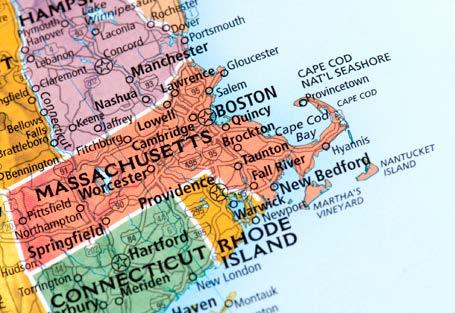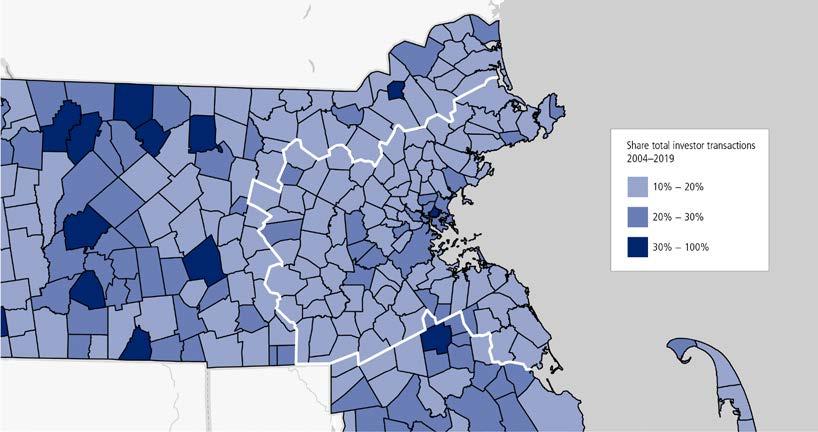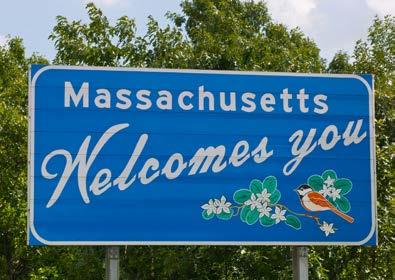
What if Quality Child Care and Early Education Were More Affordable for Massachusetts Families? 40 HIGHLY CAPITALIZED INVESTORS ARE BUYING UP HOMES ACROSS GREATER BOSTON State of the State Economy 5 14 Highly Capitalized Investors Are Buying Up Homes Across Greater Boston 26 Endnotes: New Policy Directions in Housing and Economic Development

MassBenchmarks provides timely information about the Massachusetts economy, including reports, commentary, and data about the state’s regions and industry sectors that comprise them.
Published by the UMass Amherst Donahue Institute in cooperation with the Federal Reserve Bank of Boston.
CONTRIBUTE
The editors invite queries and articles on current topics involving the Massachusetts economy, regional economic development, and key growth industries from researchers, academic or professional economists, and others. A description of the topic and brief biography of the author should be sent to massbenchmarks@donahue.umass.edu.
OUR LIBRARY
A complete list of past issues, latest news, updates, and additional research on the Massachusetts economy can be found at massbenchmarks.org.
MEDIA INQUIRIES
For more information, please contact us at kleblond@donahue.umass.edu.
The state’s economy is not as strong as initially thought, and there has been a loss in momentum.

State of the State Economy
Michael Goodman & Mark Melnik
The Massachusetts economy is clearly slowing in the face of continued inflation, high interest rates, and slight downtrends in job growth.

Highly Capitalized Investors Are Buying
Up Homes Across Greater Boston
Jessie Partridge Guerrero, Alexa DeRosa, & Timothy Viall
New research by the Metropolitan Area Planning Council found that one in every five homes in Greater Boston was sold to a speculative investor, with numerous negative impacts, including on lower income neighborhoods of color.

What if Quality Child Care and Early Education Were More Affordable for Massachusetts Families?
Randy Albelda, Alan Clayton-Matthews, Anne Douglass, Christa Kelleher, Songtian Zeng, & Laurie Nsiah-Jefferson
A multidisciplinary research team from UMass Boston developed a simulator for estimating the usage and costs of quality child care and early education in the Commonwealth and for understanding the impacts of expanding financial assistance to families.

Endnotes: New Policy Directions in Housing and Economic Development
Edward Augustus, Secretary of the Massachusetts Executive Office of Housing and Livable Communities
Yvonne Hao, Secretary of the Massachusetts Executive Office of Economic Development
Introducing new policy—and new leadership—in Massachusetts housing and economic development.
CO-EDITORS
Mary Burke
Federal Reserve Bank of Boston
Michael Goodman
University of Massachusetts Dartmouth
SENIOR CONTRIBUTING EDITOR
Alan Clayton-Matthews
Northeastern University professor emeritus
SENIOR MANAGING EDITOR
Mark Melnik
UMass Donahue Institute
EXECUTIVE EDITOR EMERITUS
Robert Nakosteen
University of Massachusetts Amherst professor emeritus
FOUNDING EDITOR
Lynn Browne
Brandeis University
Federal Reserve Bank of Boston, retired
EDITORIAL BOARD
• Katharine Bradbury, Federal Reserve Bank of Boston, retired
• Frederick Breimyer, Federal Deposit Insurance Corporation Boston
• Peter Doeringer, Boston University, professor emeritus
• Robert Forrant, University of Massachusetts Lowell
• Keren Horn, University of Massachusetts Boston
• Michael Klein, Tufts University
• Yolanda Kodrzycki, Federal Reserve Bank of Boston, retired
• Frank Levy, Massachusetts Institute of Technology, professor emeritus
• Alicia Sasser Modestino, Northeastern University
• Christopher Probyn, State Street Bank
• James Stock, Harvard University
• Jeffrey Thompson, Federal Reserve Bank of Boston
• Robert K. Triest, Northeastern University
• Paul Willen, Federal Reserve Bank of Boston
Letter from the Chancellor Javier Reyes Notes from the Board Branner Stewart
3
CONTENTS
26
2
5 14
42 1 2024 | VOLUME 26 ISSUE 1

This issue of MassBenchmarks offers important insights into what is arguably the largest threat to the economic competitiveness of our Commonwealth: the high cost of living. Appropriately, much attention is dedicated to housing affordability—a leading factor of this. The analysis and commentary contained within this issue of MassBenchmarks is well worth the careful attention of our policymakers and business and labor leaders.
As always, the issue begins with an assessment of the state economy. Dr. Michael Goodman, professor of public policy at UMass Dartmouth, and Dr. Mark Melnik, director of economic and public policy research at the UMass Donahue Institute, review recent trends and revised data that have changed our understanding of conditions in the state labor market since the pandemic. Goodman and Melnik highlight the implications of the surge in domestic out-migration that our state has experienced in recent years, which they argue is exacerbated by cost-of-living challenges and in turn exacerbates labor supply problems and constrains growth in several of our leading industries.
The first feature article explores an important but troubling trend in the Commonwealth’s residential housing market. In their insightful analysis, Jessie Partridge Guerrero, Alexa DeRosa, and Timothy Viall from the Metropolitan Area Planning Council document the significant role that speculative investors play in residential housing markets in Greater Boston. They raise important concerns about the implications for housing affordability and offer several policy recommendations.
The second feature article takes a careful look at the costs and benefits of a proposed program that would provide direct financial assistance to eligible families with young children to help them cover childcare and preschool expenses. This work was produced by an impressive multidisciplinary team led by Dr. Randy Albelda, professor emerita of economics at UMass Boston, and Dr. Alan ClaytonMatthews, professor emeritus of economics and public policy at Northeastern University who is also MassBenchmarks’ senior contributing editor. A better understanding of the level of investment required to provide all children with access to affordable and high-quality childcare and early educational options will greatly inform ongoing policy discussions about how to achieve this goal.
The issue concludes with two important messages and calls to action from Massachusetts Secretary of Housing and Livable Communities Edward Augustus and Massachusetts Secretary of the Executive Office of Economic Development Yvonne Hao. Their contributions to this issue’s Endnotes describe the Healey–Driscoll Administration’s strategic vision for a more economically competitive and livable Massachusetts.
Strategic vision and evidence-based solutions will be essential to successfully overcoming the challenges facing our state that are discussed in the pages that follow. The insights and evidence contained in this issue of MassBenchmarks will provide constructive input to our state leaders and policymakers as they work together to address these challenges.
 Javier A. Reyes Chancellor of the University of Massachusetts Amherst
Javier A. Reyes Chancellor of the University of Massachusetts Amherst
LETTER FROM THE CHANCELLOR
MASSBENCHMARKS.ORG 2

Mixed signals about the Massachusetts economy are clouding the outlook, observes the MassBenchmarks Editorial Board
The state’s economy is not as strong as initially thought, and there has been a loss in momentum

At the beginning of 2024, it appeared that the year would be a strong one for the Massachusetts economy. Amid fears of an imminent recession that never occurred, growth in real gross domestic product (GDP) in both Massachusetts and the United States stayed in expansion mode and was unexpectedly high. The growth came despite elevated interest rates that have been only partially successful, thus far, in bringing down inflation. The Massachusetts unemployment rate also hit record low levels, and jobs growth was robust (at least it seemed at the time) with most industry sectors posting gains. Recent data, however, show that the Massachusetts economy has started to cool heading into mid-2024, and the supposedly robust jobs growth seen in 2023 has been largely erased through a downward revision by the Bureau of Labor Statistics. Although a long-
anticipated recession has been averted, a slowing in the state’s economy can now be seen in weaker GDP growth, little or no jobs growth in the key professional and business services sector, and an increase in marginally attached workers (people who want work but have not looked in the past 4 weeks). The uncertainties are compounded by inflation rates that remain at higher-than-desired levels and by the risk that Massachusetts may be losing talent to other states. On the plus side, state tax revenues were strong in the all-important month of April, the working-age population experienced a recent uptick, and the unemployment rate remains low. Overall, however, the Editorial Board is now sensing a less buoyant Massachusetts economy accompanied by an increase in downside risks.
GDP
In the latter half of 2023, Massachusetts and the United States both experienced stronger than expected growth in real GDP and avoided sliding into a recession. Since reaching annual growth rates approaching 4 percent in the second half of 2023, however, the pace of growth has slowed. In the first quarter of 2024, Massachusetts GDP decelerated to a 1.8 percent annualized rate, according to MassBenchmarks, while U.S. GDP ratcheted down to a 1.6 percent annualized rate, according to the U.S. Bureau of Economic Analysis (BEA). Looking into future quarters, GDP growth rates are projected to maintain a slow-to-steady (positive) course, according to both a Wall Street Journal survey of economists as well as MassBenchmarks.
EMPLOYMENT AND UNEMPLOYMENT
While the growth in Massachusetts GDP, though slowing, remains a positive feature of the state’s economy, the trends in payroll jobs are less sanguine. Following an adjustment by the Bureau of Labor Statistics, what had been a fairly robust picture of Massachusetts jobs growth in 2023 has become a dimmer assessment showing little or no jobs growth. Heading into mid-2024, Massachusetts jobs numbers appear to be on the rise again (payroll employment grew 1.0 percent on an annualized basis in the first 4 months of this year relative to December of last year, more slowly than the national growth rate of 1.9 percent over the same period), but uncertainty remains because these numbers, too, could be revised downward. Looking at key sectors of the Massachusetts economy, there is concern that professional and business services (which includes engineering, computer systems design, and R&D and is foundational to the state’s technologybased economy) is no longer growing. This may be a vestige of higher interest
NOTES FROM THE BOARD
2024 | VOLUME 26 ISSUE 1 33
rates and resulting difficulties in accessing capital for the sector, which in some instances has led to layoffs. Construction jobs continue to increase, led by non-building infrastructure projects, but some of the recent increases may represent a seasonal blip (noting that non-building construction has been leading the numbers for over a year now) due to the mild winter. Leisure and hospitality, as well as the state’s key healthcare and education sector, are also experiencing growth.
The Massachusetts unemployment rate remains close to historic lows, at 2.9 percent in March compared with 3.8 percent for the United States. At this point in the economic cycle, most remaining slack in the labor market has been soaked up, making it more challenging to fill additional jobs moving forward. A slight uptick in the state’s marginally attached labor force during the first quarter of 2024, however, may indicate that the pool of available workers is still increasing, although that uptick could instead be an early sign of a weakening economy.
DOMESTIC OUTMIGRATION AND IMMIGRATION
The Editorial Board had an extensive discussion about the implications of a concerning outward flow of Massachusetts residents moving to other states, in combination with the state being one of the most popular destinations for people coming into the United States from other countries. Both have major ramifications on labor force growth and shaping public policy. While the state has lost population to other states for decades, the trend became more acute in 2021 and 2022. Although 2023 showed some improvement, net negative outmigration is a longterm structural issue for Massachusetts, and the overall trend has been toward increased outmigration. High housing, childcare, and healthcare costs may be affecting decisions to move as well as taxation, congestion, and unreliable public transit. Massachusetts’ strengths in professional services and technology also promote remote work, which, in turn, makes it possible to still work for a Massachusetts business but from new homes in Maine, New Hampshire, Florida, or elsewhere. Recent studies have demonstrated a proclivity for the young and educated to leave Massachusetts. Longer term, this dynamic—should it persist at higher levels—will erode the state’s overall competitiveness, and initiatives will need to be redoubled to retain and attract talent to the state.
Counteracting the movement of people to other states, Massachusetts continues to be a magnet for foreign in-migrants. That, combined with natural increases in population (births minus deaths), has allowed the state’s population to grow in most years, albeit slowly. A recent influx of immigrants into the United States as reported by the Congressional Budget Office (CBO) may be starting to percolate to the Massachusetts working-age population, which is now on a relatively strong upward growth trajectory after showing essentially no growth for several years. Much of the immigrant population coming into Massachusetts have skills learned in their native countries that can benefit the state’s businesses once necessary permits
and jobs placements have been executed. Policies to engage immigrants effectively and bring them quickly into the labor market and onto career paths represents an opportunity for the Massachusetts economy by providing a pipeline of new workers. Although this can be an extended process, potentially large positive employment impacts due to increased in-migration may be seen in Massachusetts in coming years.
CONCLUSION
As Massachusetts heads into the mid- and latter parts of 2024, there is an increasing sense of caution concerning the direction of the state’s economy. The economy is not as strong as first thought, and there is a perceptible loss in momentum, notably in jobs and slowing growth in GDP. Economic growth in the state, along with the national economy, likely peaked in the second half of 2023, and slower growth is now anticipated for 2024. The slowdown may be due, in part, to the delayed effects of higher interest rates finally coming home to roost. With the slowdown in growth, the question of whether there will be a recession in coming quarters reemerges (noting that none is currently forecast) or whether instead the state and nation are headed for a “soft landing” phase of slow but stable growth and lower inflation. On the positive side, inflation concerns may be slowly ebbing, interest rates have plateaued, some demographics are becoming more favorable for population and workforce growth, and Massachusetts’ state tax revenues are meeting or exceeding expectations. The overall message about the state’s economy is currently quite mixed, which points to a continuing need to adapt to the disruptions and uncertainties of the post-pandemic economy.
This summary reflects the discussion of the members of the Editorial Board of MassBenchmarks at its spring meeting on May 3, 2024, and it reflects the economic data available up to that date. It was prepared by Branner Stewart, senior research manager at the UMass Donahue Institute, and was reviewed and edited by the members of the Editorial Board. While discussion among the Board members was spirited and individual Board members hold a wide variety of views on current economic conditions, this summary reflects the broad consensus of the Board regarding the current state of the Massachusetts economy.
MASSBENCHMARKS.ORG 4
State of the State Economy
BY MICHAEL GOODMAN & MARK MELNIK
The Massachusetts economy continues to expand, though signs indicate a slowdown over the next few quarters. Persistent inflation, high interest rates, and labor supply constraints are all limiting the capacity for consumer spending and economic growth. Additionally, recent revisions to benchmark employment estimates for Massachusetts have highlighted structural and demographic challenges to the economy in the near term.






2024 | VOLUME 26 ISSUE 1 5

An aging state labor force, coupled with recent patterns in domestic outmigration, continues to focus state policymakers’ attention on the cost of living and other threats to economic competitiveness.



MASSBENCHMARKS.ORG 6

Introduction
As the first half of 2024 rounds to a close, the Massachusetts economy continues to perform reasonably well. Labor market conditions in the state remain extremely tight, with the unemployment rate hovering around 3 percent. Payroll employment grew at a 2.2 percent annualized rate in the first quarter of this year, just above the national economy, which expanded at a 2 percent rate during the same period. Recent income growth has also been encouraging: According to the Bureau of Economic Analysis, state nominal wage and salary income grew at a 3.6 percent annualized rate in the fourth quarter of 2023. That said, inflation continues to challenge households in the region, with prices up 4.3 percent in the first quarter compared with the fourth quarter of 2023.
There are some reasons to be concerned. Economic growth has slowed in each of the two most
recent quarters, both nationally and in the Commonwealth. Annual benchmark revisions to payroll employment significantly changed our understanding of job growth in the state since the height of the COVID-19 pandemic. The revised data indicate that employment in Massachusetts in April 2024 remained 13,000 jobs below its pre-pandemic peak. It is important to understand that the employment revision by the Bureau of Labor Statistics (BLS) is largely driven by population factors, namely changes in birth, death, and migration to the overall population base. The COVID-19 crisis certainly led to unprecedented trends in population growth and movement that seem to be impacting what is reflected in the latest employment revisions. In short, it appears that initial employment estimates for the state assumed a larger labor supply in Massachusetts than the current revisions. These numbers will be subject to future revisions, but the
Annual benchmark revisions to payroll employment significantly changed our understanding of job growth in the state since the height of the pandemic. The revised data indicate that employment in Massachusetts in April 2024 remains 13,000 jobs below its pre-pandemic peak.
most recent change underscores the concerns about labor availability and capacity in the state.
According to the revised data, year over year, in December 2023, the BLS revisions reduced Massachusetts job growth from 1.9 percent to 0.7 percent. During the same period, U.S. job growth was 2 percent. An aging state labor force, coupled with recent patterns in domestic outmigration, continues to focus state policymakers’ attention on the cost of living and other threats to economic competitiveness. This slowing growth has taken its toll on state tax receipts. For much of Fiscal Year 2024, state tax revenues have been below consensus estimates, resulting in the need to lower expectations and to implement midyear “9C” budget cuts and other fiscal adjustments. Midway through 2024, the Massachusetts economy is clearly slowing but remains remarkably resilient.
7 2024 | VOLUME 26 ISSUE 1

Jobs and Unemployment
In recent history, the Massachusetts economy has generally outperformed the United States, with the state unemployment rate consistently below the national measure. This was especially the case during and following the Great Recession (December 2007 to June 2009). The historically low unemployment rate reflects the overall tight labor market conditions in the state, as it has in recent years. The April 2024 unemployment rate for Massachusetts was 2.9 percent, just above the historic low of 2.7 percent recorded at the end of the tech boom in the summer and fall of 2000 and
among the lowest since these data were first collected in 1969. The U.S. unemployment rate, which was 3.9 percent in April 2024, reached its lowwater mark of 3.4 percent the winter before, the lowest level since the end of the 1960s (Figure 1).
The economic downturn caused by the pandemic led to a rapid and dramatic increase in both the state and national unemployment rates. Massachusetts lost over 680,000 jobs in April 2020, equating to approximately 18.2 percent of total jobs in the state (seventh highest percentage in the nation). Since that point, month-tomonth, the state has consistently added jobs.
For much of the last year, labor market data suggested that Massachusetts had surpassed its prepandemic jobs peak in March 2023 and had been adding to that new peak in employment each subsequent month. The recent revisions to the state employment numbers, however, paint a different picture of job recovery in the state, with Massachusetts still being slightly below its pre-pandemic peak as of April 2024. It is likely that the state will surpass its pre-pandemic peak very soon, if not by the publication of this article.
■ Source: Massachusetts Executive Office of Labor and Workforce Development, Local Area Unemployment (LAU) Statistics; UMDI analysis. Note: BLS annual revisions resulted in major changes to this dataset for 2023. Massachusetts 2.9% United States 3.9% Recession Massachusetts United State s 0% 2% 4% 6% 8% 10% 12% 14% 16% 18% Jan-00 Jan-01 Jan-02 Jan-03 Jan-04 Jan-05 Jan-06 Jan-07 Jan-08 Jan-09 Jan-10 Jan-11 Jan-12 Jan-13 Jan-14 Jan-15 Jan-16 Jan-17 Jan-18 Jan-19 Jan-20 Jan-21 Jan-22 Jan-23 Jan-24 Unemployment Rate MASSBENCHMARKS.ORG 8
Figure 1: Unemployment Rates in Massachusetts and the United States as of April 2024 (Seasonally Adjusted))
Figure 2: Massachusetts Job Deficit Since the Start of the COVID-19 Pandemic (Seasonally Adjusted)
■ Source: Massachusetts Executive Office of Labor and Workforce Development, Current Employment Statistics (CES-790); UMDI analysis. Note: BLS annual revisions resulted in major changes to this dataset for 2023.
The job deficit is most pronounced in the direct-service sectors of the economy. Accommodation and food services and retail trade together are 43,000 jobs below their pre-pandemic peak. Conversely, professional and technical services, which includes a variety of high-skill knowledge-based sectors, is almost 6 percent larger than it was in February 2020, with some 20,500 more jobs than at the start of the pandemic. Nevertheless, professional and technical services in Massachusetts grew at less than half the rate of the sector nationally.
While some of the job recovery reflects macroeconomic trends and the impact of the pandemic on industries, overall, tight labor market conditions give leverage to job seekers. For instance, the job openings rate in the state is twice the hiring rate. This reflects competition for labor in a tight market where employers that can offer better wages and working conditions and remote work options have an advantage. This disadvantages more traditional industries and those heavily reliant on face-to-face interaction, foot traffic, and fully onsite work.



The job deficit is most pronounced in the directservice sectors of the economy. Accommodation and food services and retail trade together are 43,000 jobs below their pre-pandemic peak.
32 13 68 3
Mar-20May-20 Jul-20Sep-20Nov-20 Jan-21Mar-21May-21 Jul-21Sep-21Nov-21 Jan-22Mar-22May-22 Jul-22Sep-22Nov-22 Jan-23Mar-23May-23 Jul-23Sep-23Nov-23 Jan-24Mar-24
9 2024 | VOLUME 26 ISSUE 1

While the state is experiencing remarkably low unemployment and rising wages, job recovery in the state ranks just 47th in the country. For its part, the United States is 3.7 percent above its pre-pandemic peak.
One of the factors limiting job growth in the state over the last few years is the availability of labor. The COVID-19 recession, coupled with shifts in domestic and international migration and an aging population, significantly impacted the labor force size in Massachusetts. As shown in Figure 6, the state’s labor force size (i.e., those people
working or unemployed and looking for work) grew steadily between 2000 and the pandemic, with a slight slowdown starting around 2018 and 2019. The labor force dropped precipitously at the onset of the pandemic as hundreds of thousands of workers dropped out of the labor market due to retirement, health concerns, family care responsibilities, or the general lack of opportunity in the economy. Shortly after, the labor force began rebounding but has remained largely flat over the last 4 years.
Figure 3: Massachusetts Job Recovery by Industry Since the Start of the COVID-19 Pandemic
■ Source: Massachusetts Executive Office of Labor and Workforce Development, Current Employment Statistics (CES-790); UMDI analysis. Note: BLS annual revisions resulted in major changes to this dataset for 2023.
Massachusetts U.S. Industry Feb–20 April–24Change (N)Change (%)Change (%) Accommodation and food services 324,000 301,000 (23,000) (7.1%) (1.1%) Retail trade 350,000 330,000 (20,000) (5.7%) 1.1% Manufacturing 242,900 234,500 (8,400) (3.5%) 1.4% Information 95,600 92,500 (3,100) (3.2%) 3.6% Government 465,900 462,800 (3,100) (0.7%) 1.8% Management of companies and enterprises 73,400 71,300 (2,100) (2.9%) 2.9% Other services 142,100 140,200 (1,900) (1.3%) (0.6%) Wholesale trade 123,100 122,700 (400) (0.3%) 4.7% Real estate and rental and leasing 49,000 48,800 (200) (0.4%) 5.7% Mining and logging 1,000 1,000 0 0.0% (6.3%) Arts, entertainment, and recreation 63,400 63,800 400 0.6% 6.1% Administrative and waste services 185,000 187,100 2,100 1.1% 1.5% Educational services 185,000 187,200 2,200 1.2% 1.9% Transportation, warehousing, and utilities 105,300 107,900 2,600 2.5% 13.8% Finance and insurance 178,200 181,500 3,300 1.9% 3.5% Health care and social assistance 645,700 653,400 7,700 1.2% 7.4% Construction 165,900 176,200 10,300 6.2% 7.9% Professional and technical services 350,600 371,100 20,500 5.8% 13.3% Total non-farm 3,746,1003,733,000 (13,100) (0.35%) 3.9%
MASSBENCHMARKS.ORG 10
Figure 4: Job Openings Rate and Hire Rate in Massachusetts, December 2000–March 2024 (Seasonally
■ Source: U.S. Bureau of Labor Statistics, Job Openings and Labor Turnover Survey (JOLTS); UMDI analysis.
Figure 5: Job Recovery Rates in Massachusetts and All States, February 2020 and April 2024 (Seasonally Adjusted)

■ Source: Massachusetts Executive Office of Labor and Workforce Development, Current Employment Statistics (CES-790); UMDI
Adjusted) 3.2% 5.7% 0% 1% 2% 3% 4% 5% 6% 7% 8% 9% Dec-01 Dec-02 Dec-03 Dec-04 Dec-05 Dec-06 Dec-07 Dec-08 Dec-09 Dec-10 Dec-11 Dec-12 Dec-13 Dec-14 Dec-15 Dec-16 Dec-17 Dec-18 Dec-19 Dec-20 Dec-21 Dec-22 Dec-23 MA Hire Rate MA Job Openings Rate
annual revisions resulted in major changes to this dataset for 2023. 99.7% 87% 92% 97% 102% 107% 112% Idaho Utah Nevada Florida Arizona Montana South Carolina North Carolina Georgia Arkansas Colorado Tennessee Alabama South Dakota Oklahoma Delaware Kentucky Missouri Washington New Jersey United States Indiana Virginia Nebraska Maine New Mexico Mississippi Kansas New Hampshire Alaska California Wyoming Wisconsin Rhode Island Pennsylvania Minnesota Michigan West Virginia Oregon Connecticut North Dakota Illinois New York Vermont Massachusetts Maryland Louisiana Hawaii D.C. 11 2024 | VOLUME 26 ISSUE 1
analysis. Note: BLS
That said, labor force size has largely been unmoved over the last 2 years, and the state’s labor force is smaller today than it was pre-pandemic. With an extremely low unemployment rate and a basically unchanged labor force size, there is limited available capacity for net new job creation in the state. In this context, the BLS revisions to total employment in the state make a lot of sense. Over the last couple of years, the level of job growth in the state relative to unemployment and labor force size had been puzzling. However, the backward revision on job growth in Massachusetts underscores some of the demographic factors that are constraining economic growth.
One important factor influencing labor force size in Massachusetts in recent years is the shifting dynamics in international and domestic migration. While Massachusetts has experienced net population losses through domestic outmigration (i.e., people moving from Massachusetts to another state) over the last 20 years, these losses were almost always offset by significant gains in international migrants. Although documented international migration declined in Massachusetts during much of the Trump Administration and most significantly during the height of the pandemic in 2020 and 2021, over the last 2 years, international migration has returned to more typical levels for the state.
5 . Massachusetts Labor Force, January 2000
Nevertheless, reduced immigration during those years, coupled with a notable spike in domestic outmigration in 2022, exacerbated state labor supply challenges. In 2023, domestic outmigration returned to more typical levels for the state, but ongoing labor supply concerns have brought greater attention to domestic outmigration and its implications for the Commonwealth and its economic competitiveness.
Figure 6: Massachusetts Labor Force, February 2000–April 2024 (Seasonally Adjusted)
■ Source: Massachusetts Executive Office of Labor and Workforce Development, Local Area Unemployment (LAU) Statistics; UMDI analysis. Note: BLS annual revisions resulted in major changes to this dataset for 2023.
3,769,165
Recession L abor Force
Figure
Jan-00 Jan-01 Jan-02 Jan-03 Jan-04 Jan-05 Jan-06 Jan-07 Jan-08 Jan-09 Jan-10 Jan-11 Jan-12 Jan-13 Jan-14 Jan-15 Jan-16 Jan-17 Jan-18 Jan-19 Jan-20 Jan-21 Jan-22 Jan-23 Jan-24
3,000,000 3,100,000 3,200,000 3,300,000 3,400,000 3,500,000 3,600,000 3,700,000 3,800,000 3,900,000 4,000,000
MASSBENCHMARKS.ORG 12

Figure 7: Massachusetts Estimated Components of Population Change, 2000–2023 ■ UMass Donahue Institute. Source: Data: ST-2000-7; CO-EST2010-ALLDATA; and NST-EST2023-ALLDATA, U.S.
months
data
so
excluded.
years
2020)
omitted as those estimates are based on only a 3-month sample. Births Deaths Internationa l Migration Total Migration Natural Increase Domestic Migration - 8 0,000 - 6 0,000 - 4 0,000 - 2 0,000 0 20,000 40,000 60,000 80,000 100,00 0 2001 2002 2003 2004 2005 2006 2007 2008 2009 2011 2012 2013 2014 2015 2016 2017 2018 2019 2021 2022 2023
domestic
13 2024 | VOLUME 26 ISSUE 1
Census Bureau Population Division. Note: Components of population change data for decennial Census years are based on only 3
of
and
are
Decennial Census
(2010 and
are
One important factor influencing labor force size in Massachusetts in recent years is the shifting dynamics in international and
migration.
State Fiscal Conditions
State fiscal conditions have become an area of greater concern since the FY24 state budget was enacted in August 2023. After several years of exceptionally strong revenue growth and the accumulation of a record balance1 in the state’s stabilization, or “rainy-day,” fund, a series of tax cuts were signed into law in October 2023 with strong bipartisan support. The state Department of Revenue has estimated that by 2027, when the full package of tax cuts will be in effect, the Commonwealth’s revenuegenerating capacity will be reduced by an estimated $1 billion.2
By the conclusion of 2023, after 6 consecutive months of state tax receipts coming in below expectations, the Commonwealth found itself $769 million beneath the revenue assumptions that were used to develop the FY24 budget. Given the constitutional mandate to ensure a balanced state budget, in January, Governor Healey invoked her “9C” authority,3 which allows for unilateral budget cuts when it is evident that the state budget is out of balance. The estimated $1 billion gap in expected revenue was closed through a combination of midyear spending cuts4 ($375 million) and unanticipated nontax revenues ($675 million).5
Through the first quarter of 2024, growth in state tax receipts remained slower than expected, and at the conclusion of March, actual revenues were $145 million below the revised revenue expectations announced in January and $4 million below March 2023 receipts.6 At the time of writing, the latest data available were for April 2024. April has historically been the strongest month for tax collections, and this is the first year in which revenues from the 4 percent surtax on taxable income above $1 million takes effect.
April revenues came in well above forecast,7 and with 2 months remaining in FY24, state revenues were $889 million above the reduced consensus revenue estimate adopted in January.

While the publicly available state data are not sufficiently detailed to discern the degree to which the revenue surge in April can be attributed to the new surtax, the so-called “millionaire’s tax” was undoubtedly a significant contributor to reported revenue growth, particularly in non-withheld income tax receipts, which were over 77 percent higher in April 2024 than a year earlier and $1.147 billion (57.4%) above expectations.
The preparation of the FY25 budget is well underway, and some fiscal belt tightening is expected. The Commonwealth has been coping with unanticipated and sizable expenses associated with the significant needs of migrant asylum seekers requiring emergency shelter and related services, and the recent bankruptcy filing by Steward Health Care—which operates nine community hospitals that provide essential services in many areas of the state—may require state intervention to keep these vital institutions open and able to serve some of the most vulnerable communities in our state.
These challenges make the fiscal outlook somewhat uncertain. Nevertheless, despite rising expenses and slower economic growth, state fiscal conditions remain stable and the rainyday fund provides a solid cushion in the event of an unexpected reversal in the Bay State’s economic and fiscal fortunes.
Conclusion
Overall, the economy continues to perform well in Massachusetts and the United States; however, signs do point to a slowdown over the next few quarters. The persistence of inflation, high interest rates, and labor supply constraints are all limiting the capacity for consumer spending and economic growth in the near term. Similarly, the recent down revisions to the BLS employment estimates for Massachusetts further underscored some of the structural and demographic challenges limiting economic growth in Massachusetts.
From a policy perspective, the Commonwealth should continue focusing on a mix of initiatives that make Massachusetts an attractive and more affordable place to live, work, and start a business, and that invest in residential labor supply to ensure we are maximizing the talent and potential of workers in all corners of the state.

MASSBENCHMARKS.ORG 14
The Commonwealth should continue focusing on a mix of initiatives that make Massachusetts an attractive and more affordable place to live, work, and start a business.




Michael Goodman is executive director of Economic Development & Community Partnerships & Strategic Initiatives and professor of public policy at the University of Massachusetts Dartmouth and co-editor of this journal.
Mark Melnik is the director of the UMass Donahue Institute Economic & Public Policy Research Group and senior managing editor of this journal.
Endnotes
1) https://cthru.data.socrata.com/stories/s/eqrd-tdvi
2) https://www.mass.gov/news/governor-healeysigns-first-tax-cuts-in-more-than-20-years
3) https://malegislature.gov/Laws/GeneralLaws/PartI/ TitleIII/Chapter29/Section9C
4) For details on the 9c cuts, see https:// www.masstaxpayers.org/sites/default/files/ publications/2024-01/FY%202024%20Revenue%20 Shortfall%20%26%209C%20Cuts%20FINAL.pdf
5) Unanticipated revenues included interest earned on the general fund balance, stronger than expected revenues from the lottery and gaming, among others. op.cit.
6) https://www.mass.gov/news/march-revenuecollections-total-4065-billion
7) https://www.mass.gov/news/april-revenuecollections-total-6324-billion
15 2024 | VOLUME 26 ISSUE 1

Research finds that 21% of residential properties sold in Greater Boston from 2004 through 2018 were purchased by an investor.

Highly Capitalized Investors Are Buying Up Homes Across Greater Boston
New research has found that from 2004 to 2018, one in every five homes was sold to an investor, with significant impact on
lower income neighborhoods of color
JESSIE PARTRIDGE GUERRERO, ALEXA DEROSA, & TIMOTHY VIALL
Decades of inadequate housing production and strong economic growth have led Massachusetts into its current housing crisis. Speculative investment in the housing market exacerbates this crisis.
Speculation in the housing market is an emerging issue in communities across the United States. Home sale prices in many regions continue to rise, and while rents in many cities dipped early in the COVID-19 pandemic, most are now back to or above pre-pandemic peaks. Potential buyers seeking a home to live in often find themselves in bidding wars, sometimes against investors who have cash on hand to offer.

Residents, tenant organizations, and nonprofit affordable housing developers have felt rental-market pressure from speculators buying residential properties as investment opportunities and subsequently raising rents sharply, evicting lower income tenants in favor of higher paying tenants, converting units to condominiums, flipping units for a large profit, or leaving them to sit empty, thereby taking precious units off the market.
Housing is necessary for survival, and homeownership is one of the cornerstones of building wealth in America. Homebuyers often expect the return on a home investment to be higher than inflation, a savings account, or even the stock market. This investment is aided by significant tax benefits that occur both during the time one lives in their home and when they sell it.
However, the path for a family to purchase a single-family home, a condo, or a triple-decker to live in and rent out is becoming further out of reach because of the unprecedented pressure on the housing market.
In today’s Boston Metro housing market, one needs an annual income of nearly $200,000 to afford a median-priced home.1 Renters also struggle to afford a place to stay, with rent increases outpacing income growth. Just over half of Greater Boston renters spend more than 30% of their income—and over a quarter spend more than 50% of their income—on housing costs.2
MASSBENCHMARKS.ORG 16
Speculative Investment Exacerbates the Housing Crisis
Decades of inadequate housing production across Greater Boston, coupled with strong economic growth attracting workers to the region, and resulting shortages in housing stock have led to today’s housing crisis. Amid this crisis, another phenomenon has emerged that has only worsened the situation: investors betting their funds on housing. Sometimes called corporate investors, institutional investors, or speculators, these entities purchase residential property with profit, not shelter, as their primary goal. Research conducted by the Metropolitan Area Planning Council (MAPC) has examined the scale and scope of housing investment as a practice in Greater Boston.
MAPC is a public agency created under Massachusetts General Law Chapter 40B Section 24 and is governed by representatives from the 101 cities and towns in its designated region (Greater Boston), as well as gubernatorial appointees and designees of major public agencies. MAPC works toward sound municipal management, sustainable land use, protection of natural resources, efficient and affordable transportation, a diverse housing stock, public safety, economic development, clean energy, healthy communities, an informed public, and equity and opportunity for people of all backgrounds. As a government research organization, MAPC seeks to understand the “on the ground” conditions of Massachusetts residents, workers, businesses, and ecosystems, and the trajectories along which they are moving. Much of the agency’s research is grounded in and guided by MetroCommon 2050—Greater Boston’s regional land-use and policy plan.

Buying Obstacle
In today’s Boston Metro housing market, one needs an annual income of nearly $200,000 to afford a median-priced home.

Renting Obstacle
Just over half of Greater Boston renters spend more than 30% of their income—and over a quarter spend more than 50% of their income—on housing costs.

■ Note. This map represents data from the Homes for Profit report. The MAPC region is outlined in white. The interactive map available online allows users to select a geography across Massachusetts on the map to see the data. See https://homesforprofit.mapc.org.
Figure 1: MAPC Region
2024 | VOLUME 26 ISSUE 1 17
The impact of speculative investment cannot be overstated. Not only do investors take properties off the market that could otherwise be sold to families intending to live in a home, but renters often suffer when large-scale investors buy their buildings and hike their rents, if not evict them outright without cause. Through several case studies of buildings recently sold to investors in the Greater Boston area, MAPC found that new investor-owners, often those with large real estate portfolios hidden behind numerous limited liability companies (LLCs), asked long-term tenants to pay rent increases of up to 70% or leave the building they had long called home.
Through an analysis of residential real estate transactions, MAPC’s research found that, from 2004 through 2018, 21% of residential properties sold in Greater Boston (as defined by the 101 cities and towns in the agency’s region) were purchased by an investor.
To conduct their analysis, MAPC relied on real estate transaction data purchased from The Warren Group, which included all residential property transactions in the MAPC region from 2000 through 2022. The data included the address of each property, the name of the buyer—whether an individual,
company, trust, or bank—the property type, and the previous sale date and price of the unit, along with many other details. With this information, MAPC revealed evidence about investment in Greater Boston’s housing market that, to the agency’s knowledge, does not otherwise exist.
The Warren Group dataset included just over one million real estate transactions in the MAPC region. As Table 1 shows, the vast majority of transactions (87%) are single-family home and condominium purchases.
Four types of residential property investors were defined in the analysis: (1) count investors, who purchased more than three residential properties within any 5-year window in the study period; (2) LLC investors, who purchased any residential property through an LLC; (3) building investors, who purchased any residential building with four or more units; and (4) value investors, who spent at least $3.45 million on residential properties over the 23-year period, or an average of at least $150,000 annually throughout the period. These definitions are not mutually exclusive, and many investors are classified as multiple investor types.

53.9% 7.8% 3.1% 33.0% 1.1% 1.1% 543,858 78,636 31,317 332,744 11,029 11,360 Residential 1 Family Residential 2 Family Residential 3 Family Condominiums Residential Apartments Other Residential Buildings Residential Type # of Transactions % of Transactions ■
MASSBENCHMARKS.ORG 18
Table 1: Real Estate Transactions by Residential Type, MAPC Region, 2020–2022
Source: The Warren Group.









The investors were categorized into four investor size groups, with small, medium, large, and institutional investors defined respectively by their total annual spending and the scale and pace of their acquisitions during the study period.
MAPC also investigated the practice of "flipping" properties, defined as any property sold within 2 years of its most recent
purchase date, with notable exceptions for foreclosures and same-day sales. The frequency of flipping and the resale margin for flipping properties by investors and non-investors were examined. In addition, the research explored the spatial patterns of residential investment and flipping, and the underlying racial and socioeconomic dynamics those patterns reveal.
Figure 2: Investor Purchases by Residential Building Type and Year, MAPC Region, with Foreclosures
44% 20% 11% 25% 60,659 27,161 15,687 34,159 Small Medium Large Institutional Investor Size # of Transactions % of Transactions 0% 10% 20% 30% 40% 50% 60% 20042006200820102012201420162018 Share of Purchases Made by Investors
Table 2: Real Estate Investor Transactions by Investor Size, MAPC Region, 2020–2022
Investor Purchases by Residential Building Type and Year,
All Residential Types Three Family Two Family Single Family Condominiums NEW LISTING NEW LISTING NEW LISTING NEW LISTING NEW LISTING FOR SALE SOLD SOLD SOLD ■ Source: The Warren Group. 19 2024 | VOLUME 26 ISSUE 1
Figure 2 MAPC Region, w ith Foreclosures
of investors who purchased condominiums during the study period did so in cash, with similarly high proportions for single-family (43%)
two-family (45%)
three-family (39%)

Cash Gives Investors an Advantage
This research exposed clear and worrisome trends in residential real estate investment in Greater Boston. In addition to finding that one in five residential transactions from 2004 through 2018 were conducted by investors, the analysis found that the rate of residential investor activity has grown over time. While investor activity represented 16% of sales in 2004, that number rose to 23% in 2018, with significantly higher investment rates in two-family (over 30% in 2018) and three-family (nearly 50% in 2018) acquisitions. The analysis also found that investors come to the table with a clear advantage: cash. Cash offers are more appealing to sellers than traditional mortgages—so much so that cash offers are often accepted even if they are not the highest bid, allowing buyers to purchase properties at a discount. Cash-sale purchases have grown from less than 15% of all sales in the years between 2000 and 2006 to more than 20% of sales since 2012, with spikes up to more than 30% in the years following the 2008 recession. More than half of investors who purchased condominiums during the study period did so in cash, with similarly high proportions for single-family (43%), two-family (45%), and three-family (39%) purchases.
43% 45% 39% 51% 12% 14% 14% 23% Single Family Two Famil yT hree Family Condominiums
rcent of Proper tie s Purchase d w ith Cash by Inve stor Status and Re al Estate Type , MAPC Re gion, with Fore closures, 2004 -2018 Investor Non-investor 0% 10% 20% 30% 40% 50% 60% +50%
Figure 3: Percent of Properties Purchased with Cash by Investor Status and Real Estate Type, MAPC Region, with Foreclosures, 2004–2018
Pe
MASSBENCHMARKS.ORG 20

Cash buying puts investors at an advantage over non-investors because cash sales are typically more attractive to sellers, who then do not have to deal with financing paperwork and can therefore close on their sale faster. And as MAPC's analysis showed, cash sales often allow investors to purchase property at a discounted price. The median sale price for cash-purchased properties, including condos, one-, two-, and three-family homes, was consistently lower than that of properties of the same sizes purchased with a mortgage. The differential between cash and non-cash sales appears to widen right after the Great Recession and continues through to today. In 2020, the difference between the median price for cash and non-cash sales was $100,000. The price differential is notable for all residential property types but is most significant for single-family and threefamily homes. This price differential is another way investors are cutting noninvestors out of the market even further.
Although investors may be able to purchase properties at a discount, collectively their dollars add up. In 2018, the total dollar amount spent by investors on residential property in Greater Boston was nearly $10 billion, up $2 billion from 2004 after adjusting for inflation.
High-Density, Racially and Ethnically Diverse Urban Markets Are Impacted the Most
The research also showed that lower income neighborhoods of color are those most likely to experience housing speculation. Lower income neighborhoods and communities of color have experienced the effects of systemic racism for generations, from redlining and segregation to subprime loan predation and mortgage discrimination. Today, many of these neighborhoods are home to some of the last remaining unsubsidized affordable homeownership opportunities in the region.
MAPC found that, rather than going to residents who identify as Black, Indigenous, and people of color (BIPOC) or first-time homeowners, many homes are going to speculators. Households of color in Greater Boston are significantly less likely to own their homes than White households. In 2021, two-thirds of White heads of households owned their homes, whereas one-third of Black, half of Asian, and only 29% of Latine heads of households in the region owned their homes.3
Black and Latine mortgage applicants,
even those with high incomes, are much more likely to be denied a loan than White applicants.4 State and federal programs focusing on low-income or first-generation homebuyers may seek to reduce the racial wealth gap, but these programs are often not equipped to function in a fast-moving housing market and are rarely sufficient to compete with cash buyers.
Using its own housing submarket research to analyze investor activity in Greater Boston’s varied housing markets, MAPC found that investor activity is most likely to occur in the region’s high-density urban submarket with relatively low housing prices (Submarket 2 in Figure 4), which is home to the highest share of renters, BIPOC, and immigrant populations among the region’s seven submarkets. A housing submarket is defined as a collection of neighborhoods—some next to each other, some not—with similar housing stock and housing market characteristics.

21 2024 | VOLUME 26 ISSUE 1
Figure 4: Housing Submarkets
WHAT ARE SUBMARKETS?
A housing submarket is a collection of neighborhoods— some next to each other, some not—with similar housing stock and housing market characteristics. These characteristics determine who can find, afford, and remain in suitable housing in that neighborhood.
Investors made nearly one-third of all purchases over the study period in Submarket 2, which includes areas of Roxbury, Chelsea, Framingham, and Lynn. Households in this submarket already face the highest cost burdens, with a quarter of households spending more than half their income on rent. Investor activity was highest in urban markets, including in Submarket 1, the densest submarket with the second highest prices, as well as in the moderate-density, moderately priced Submarket 3, which has a mix of high- and low-cost housing
The neighborhoods in each submarket share common needs and challenges, regardless of geographic location. MAPC's study revealed seven distinct housing submarkets in the Greater Boston region.
Submarket 1 High-Density Urban, High Prices
Submarket 2 High-Density Urban, Lower Prices
Submarket 3 Moderate-Density Urban, Moderate Prices
Submarket 4 Low-Density Urban-Surburban Mix, Lower Prices
Submarket 5 Low-Density Surburban, Highest Prices
Submarket 6 Low-Density Surburban, Mixed Prices
Submarket 7 Low-Density Surburban, Moderate Prices
and racial and immigrant populations comparable to the regional average. Submarket 1 includes areas such as Downtown Boston and is characterized as a premium-priced, high-density submarket with increasing home prices and rents. Submarket 3 includes areas with moderate density and older housing stock such as areas of Dorchester, Somerville, and Lynn.
While there was less investor activity in suburban markets with high prices, they too have experienced an increase in investor activity since the 2008 recession.
22 MASSBENCHMARKS.ORG
Share of Transactions that are Inve stor Purchases by MAPC S ubm arket, w ith Fore closures, 2004-2018
5: Share of Transactions That Are Investor Purchases by MAPC Submarket, with Foreclosures, 2004–2018
Large-Scale Investors Flip Homes for Profit
MAPC found that 9% of residential buildings bought in Greater Boston between 2002 and 2022 were flipped within the next 2 years, with the highest flip rates among apartment buildings (12%) and three-family homes (11%). Large and institutional investors were the most likely to flip the homes they purchased, with nearly a quarter of single-family homes and a fifth of twofamily homes purchased by large or institutional investors being flipped, compared with rates of just 8% and 9%, respectively, for non-investor buyers.
While the analysis showed that investor purchase activity jumped during the Great Recession, there was a lull in flipping activity in the years leading up to and immediately after the recession. Flip rates before the recession were high, reaching 12% of all purchases in 2003, and declined to a low of 6% in 2007 through 2009. Rates increased to 10% by 2014 and stayed relatively steady at 9% or 10% through 2019.
6: Percent of Purchases That Became Flipped Properties by Year, MAPC Region, Excludes Foreclosures
23% 31% 25% 19% 20% 19% 17% 1234567 MAPC Submarket High- and Moderate Density Low Density
Figure
Figure
2002200420062008 2010 20122014201620182020 Pe rcent of Purchases That Be came F lipped Proper ties by Ye ar, MAPC Re gion, Exclude s Fore closures 0% 2% 4% 6% 8% 10% 12% 14% 23 2024 | VOLUME 26 ISSUE 1
Figure 6. Flipped
While flips occurred at similar rates across submarkets, MAPC found that flipping was most common in Greater Boston’s highest value submarket, Submarket 5. Comprising low-density, high-value suburban areas, flips in this submarket contribute to pushing already “exclusive” neighborhoods further out of reach for the average Massachusetts resident. Finally, the agency found that investors resell their flipped properties for significantly more than the original purchase price, compared with non-
investors. Since 2010, investors who flipped their single-family properties have seen median resale prices 55% to 85% higher than they originally paid for the properties; by comparison, non-investors who flipped single-family properties have seen median resale prices only 12% to 25% higher in the same period.
Flips have two important impacts on the region’s housing market. First, they take lower priced houses off the market for potential owner-occupant buyers.
In 2020, the median purchase price for a home or building that will ultimately be resold within 2 years was $160,000 less than it was for those not sold within 2 years. That price differential has been steadily climbing since 2014. Second, homes that are flipped are resold at a higher price, significantly higher when an investor is doing the flipping. These dynamics combined—that is, purchasing at a discount and flipping at a profit— make it hard, if not impossible, for an average family to purchase in the market.
0% 5% 10% 15% 20% 25% Ap artmentBuild in gs Condomi niumsSingleF amil yTwo
Th
Pe rcentofPurchases that Be come F lippe dPrope rtie sbyInvestorS iz eand Re al Estate Type ,M APCRegion, Exclude sF oreclosure s, 2004-
Family
reeFamil y
InstitutionalLargeMediumSmallNon-investor Births Deaths Internationa l Migration Total Migration Natural Increase - 2 0,000 0 20,000 40,000 60,000 80,000 100,00 0
Figure 7
Foreclosures,
Figure 7: Percent of Purchases That Became Flipped Properties by Investor Size and Real Estate Type, Excludes
2004–2018
without Foreclosures (2004–2018) -10 0 10 20 30 40 50 60 70 80 90 2004 2006 2008 2010 2012 2014 2016 2018 Percent
Figure 8: Median Percent Difference in Sales Price of Flipped Single-Family Homes, by Investor Type, MAPC Region,
All Other Investors Institutional InvestorsNon-investor MASSBENCHMARKS.ORG 24
Median Percent Di erence in Sales Price of F lipped Single Fam ily Homes, by Investor Type, MAPC Region, w ithout Foreclosures
Since 2010, investors who flipped their single-family properties have seen median resale prices 55%–85% higher than they originally paid for the properties.

The Impact of Investment on the Greater Boston Housing Market
The data MAPC analyzed from the past 2 decades tell an important story about the impact of investment activity on the Massachusetts housing market. The already competitive housing market is made even more crowded and out of reach by the presence of investors. Investor purchases account for 21% of all transactions in the MAPC region over the study period and are most prevalent in the two- and three-family home market, reaching 30% and 50%, respectively, in 2018. Investors are more likely to pay for properties using cash, often allowing them to purchase properties at lower prices than non-cash buyers. Although investment happens across the region, lower cost urban neighborhoods of color experience the highest rate of investment activity, adding to displacement pressures and restricting homeownership opportunities. Institutional and large investors are buying up large swaths of properties at a discount and flipping them at a premium, further adding to the rapid increases in prices around the region.
Speculators are able to take off the market the little remaining naturally occurring affordable housing in the Greater Boston region. This investor activity exists because market systems and government policies have enabled housing to become a lucrative commodity rather than a necessity for survival and a human right. In their current form, these systems and policies—and the investment activities they allow—make the state’s goals of expanding homeownership opportunities and reducing racial wealth disparities an uphill battle that will be hard to win.
One of the reasons investors can profit in this market to the degree they do is the lack of supply and relatively inelastic demand for housing in the Greater Boston region. An increase in housing supply is profoundly needed in the region, yet increased supply alone will not solve the housing crisis. It is nearly impossible for the average household to compete with investors who can pay cash for properties, resell, and use their profits to buy more housing. In addition, investors are likely to purchase properties from the existing housing stock instead of more expensive new construction. This leads to the existing, more naturally affordable housing stock moving out of reach for the typical buyer.
In addition, financial resources that communities invest in their neighborhoods often generate an increase in property values, beyond the investment of individual property owners. The increase in property value that a homeowner sees because of a new mural down the street or a cleaned-up community garden may have very little or nothing to do with the individual property owner. How different would the community look if that increase in property value were invested back into the neighborhood in the form of more attainable, affordable housing opportunities or more stable rental options?
The current housing system does not work well for many low- to moderateincome renters and prospective homebuyers, while allowing a few investors to make immense profits. It is critical to begin examining the impact of the commodification of housing not only on the Commonwealth’s ability to house people today, but also for future generations. The practice of housing speculation is unsustainable as a whole and will make it more difficult to achieve safe and stable shelter for all in communities throughout the region.
25 2024 | VOLUME 26 ISSUE 1

Table 3: Recommended State and Local Government Actions to Reduce Speculative Real Estate Investment and to Mitigate Its Impacts on Tenants and Local Housing Markets
• Local option tenant right of first refusal, with financial support
• Local option rent stabilization
• LLC ownership transparency Discouraging Speculation
• Local option transfer fees
• Statewide deeds excise tax
• Deeper foreclosure protections for owners and renters
• Residential Assistance for Families in Transition (RAFT)
• Massachusetts Rental Voucher Program (MRVP)
• First-time homebuyer assistance
• Foreclosure protections
• Foreclosed property sale for affordable housing
• Local property tax rate reform

Generating Resources Providing Assistance 26 MASSBENCHMARKS.ORG

Policy Recommendations to Reduce Real Estate Speculation
In response to these trends, MAPC recommends a set of policy solutions to discourage speculation, generate revenue for affordable housing from the speculation that does occur, and provide housing assistance and greater stability to Massachusetts residents. Policies such as establishing a tenant right of first refusal and regulating rents, as well as state and local foreclosure protections and acquisition programs, first-time homebuyer assistance, and municipal property tax reform could help improve housing affordability in Massachusetts, especially by retaining the affordability of some of the housing that already exists. Where implemented, these policies reduce incentives for speculation by expanding market access for affordable housing developers, limiting the potential profits from speculation, and better enabling low- and moderate-income homeowners to stay in their homes. MAPC further identified local option transfer fees and statewide deeds excise increases as potential mechanisms to capture and reinvest revenue from investment activity. Through their basis in a percentage of a property’s value, these mechanisms allow both state and local government to ensure that revenue generated for affordable housing can
keep pace with rapid escalations in housing costs. Transfer fees have the added benefit of potentially deterring speculative investors with large portfolios and disincentivizing shortterm flipping. These mechanisms ensure that a measure of the value, which investors extract from communities, is reinvested in those communities to mitigate housing instability and, along the way, help to reduce housing instability brought on by speculators buying up residential real estate without community benefit in mind.
Finally, MAPC has also recommended legislation to provide transparency into limited liability company ownership. The lack of transparency into LLC ownership and the end destination of LLC profits makes it difficult to determine which individuals or entities have an interest in an LLC, shielding investors from proper review of conflicts of interest involving an LLC’s real estate transactions, obscuring tax liability, and making the landscape of speculative investment hard to analyze. Providing greater transparency into the individuals or entities that have a beneficial interest in an LLC would both improve state government’s ability to pursue legal action in cases of conflicts of interest and better shield against tax evasion. Such transparency would also give tenants, researchers, and housing advocates more visibility into property ownership—and thus into who is shaping their communities.



Endnotes
1) Redfin News, “Homebuyers Must Earn $115,000 to Afford the Typical U.S. Home. That’s About $40,000 More Than the Typical American Household Earns,” October 17, 2023, https://www.redfin. com/news/ homebuyer-income-afford-home-record-high/.
2) The Boston Foundation, 2023 Greater Boston Housing Report Card, November 14, 2023, https:// www.tbf.org/news-and-insights/reports/2023/ november/2023-greater-boston-housing-report-card.
3) Data Source: American Community Survey, 5-Year Estimates, 2017-2021.
4) Metropolitan Area Planning Council, Metro Boston Regional Indicators, 2022, https://mapc.gitbook. io/metrocommon-x-2050-indicators/high-incomemortgage-denial-rate-gaps-by-race-and-ethnicity
Jessie Partridge Guerrero is the director of data services at the Metropolitan Area Planning Council.
Alexa DeRosa is regional planning data analyst with the Metropolitan Area Planning Council.
27 2024 | VOLUME 26 ISSUE 1
Timothy Viall is a senior communications specialist with the Metropolitan Area Planning Council.
What if Quality Child Care and Early Education Were More Affordable for Massachusetts Families?

A UMass Boston research team developed a simulation model to estimate usage, costs, employment, and poverty impacts of Massachusetts legislation providing financial assistance for high-quality child care and early education to families. Findings indicate that assistance would enable 34% more children to access licensed care, substantially reducing the cost burden for many families. With more parents able to afford reliable care, some, especially mothers of young children, will be able to increase their employment. Additional earnings would lift some families out of poverty. This family assistance investment in child care and early education would cost $1.7 billion annually.
Introduction
The COVID-19 pandemic made it clear just how essential affordable, high-quality, and accessible child care and early education is for children, families, employers, and the economy. Economists have long recognized education as a public good—a good whose benefits reach far beyond those directly engaged in the purchase and use of that good or service. When public goods are privately produced in markets, their cost is high and typically underproduced. This means that only those who can afford to pay for child care and education will be able to purchase high-quality care, resulting in inadequate supply and increased inequities.
Child care and early education could be considered a “super” public good, representing a form of social infrastructure. The return on investment in non-parental quality care is well documented.1 When children receive
stimulation, socialization, and education, it enables them to be and do well. It is also an important “input” that facilitates the ability to conduct our economic lives. Quality and dependable child care and early education allows parents, particularly mothers, to gain and keep employment, in turn allowing businesses to operate more smoothly. A recent study by the Massachusetts Taxpayers Foundation found that “insufficient child care costs the Massachusetts economy roughly $2.7 billion in earnings, higher business expenses, lost productivity, and foregone tax revenue each year.”2 There is a strong case to be made for public funding of early education and care, especially in Massachusetts, where inequality is high and employers face tight labor markets.
All levels of government are already investing in child care and early education through federal government grants, the
RANDY ALBELDA, ALAN CLAYTON-MATTHEWS, ANNE DOUGLASS, CHRISTA KELLEHER, SONGTIAN ZENG, & LAURIE NSIAH-JEFFERSON
28 MASSBENCHMARKS.ORG
Head Start Program, and state and local funding for pre-K. However, this investment does not reach the majority of families using child care and early education. Most federal and state programs are targeted toward poor and low-income families, and these programs have lengthy waiting lists. And while public pre-K has expanded in recent years, it serves only a fraction of children (ages 4 and 5, primarily). In short, despite the benefits of high-quality early education and care and the high need, there is not enough available, and what is available is often expensive, despite the low wages of early educators.
Child care and early education is a priority for many elected officials, including Governor Maura Healey. Legislation to make high-quality child care and early education more affordable for families, ensure appropriate
compensation and benefits for educators, and provide stable funding to providers is being considered by Massachusetts lawmakers. Several bills have been filed, with a broad coalition of stakeholders advocating for changes to ensure a stable, equitable, high-quality child care and early education system that lowers the cost burden on families. Research has indicated that financial assistance for child care leads to more licensed care for children in families that cannot currently afford it, resulting in higher quality care, which in turn improves educational, social, and economic outcomes for children.4
Making quality care more affordable for families affects the decisions parents make about the care and education their children receive. It also allows for more reliable care for longer periods, which paves the way for both increased and
more stable employment for parents, especially mothers. This boosts the economic status of families, including lifting some out of poverty, and has advantages for employers.
To better understand some of the impacts of expanding financial assistance to families for child care and early education, a multidisciplinary team of researchers from UMass Boston, through the Early Education Cost and Usage Simulator Project (CUSP; see box), developed a statistical model that simulates parents’ decisions about care usage to estimate how much more licensed care may be needed in Massachusetts and what employment and income changes may take place with increased access to affordable licensed quality child care and early education.
UNIVERSITY OF MASSACHUSETTS BOSTON EARLY EDUCATION COST AND USAGE SIMULATOR PROJECT (CUSP)
Led by the Institute for Early Education Leadership and Innovation17 and the Center for Women in Politics and Public Policy, the UMass Boston Early Education Cost and Usage Simulator Project (CUSP) produces current, relevant, accurate, and responsive estimates about the key impacts of proposed legislation to expand access to affordable, quality child care and early education. With financial support from the Commonwealth’s Children Fund, the project’s multidisciplinary team has developed a simulator—a tool for analyzing changes in the utilization of licensed care and education, out-of-pocket costs for families, parental employment, and family income when eligible families pay considerably less for quality child care and early education.
The team released its first research brief in October 2023, with forthcoming products aimed at providing additional information to guide policymaking around child care and early education affordability, quality, and access in Massachusetts. Future publications will focus on the demographic characteristics of families and children, geographic analyses of anticipated demand and current supply of early childhood educators, and cliff effects of proposed legislation with potential mitigation approaches.
UMass Boston’s Institute for Early Education Leadership and Innovation provides the leadership development opportunities and infrastructure that early educators need to support thriving children and families. Founded in 2016, the institute drives systems change by cultivating effective leaders who reflect and represent their communities—through workforce and leadership development, research, and partnerships that strengthen the larger early education ecosystem. UMass Boston’s Center for Women in Politics and Public Policy, established in 1994, aims to promote diverse women’s leadership to achieve more just, equitable, and responsive public and institutional policies and meaningful inclusion. Through its innovative educational programs, policy-relevant research, and public forums, the center works to ensure that the voices, expertise, and experiences of all women are valued and included in civic discourse and the policymaking process.
CUSP Website: https://www.umb.edu/earlyedinstitute/research-policy
29 2024 | VOLUME 26 ISSUE 1

Methods
Estimates related to child care usage behavior are based on data from the 2019 National Survey of Early Care and Education (NSECE) household survey, sponsored by the Office of Planning, Research, and Evaluation (OPRE) in the U.S. Department of Health and Human Services Administration for Children and Families (ACF). This nationally representative, publicly available survey includes 8,576 households with 15,981 children under 13 years of age, with basic demographic, parental employment (i.e., weekly hours of employment, training, and education), and income information about adults in the household and detailed information on early care and education usage for each child in the household, including hours of care, types of care, and out-of-pocket costs during the survey week. The survey is used to estimate the probability of a child using each of several types of child care, conditional on the child’s and their family’s characteristics. This information is also used to estimate weekly hours of care and weekly out-of-pocket costs of care for the child.
To obtain estimates of child care usage in Massachusetts, the simulator runs scenarios for each child in the U.S. Census Bureau’s 2015–2019 American Community Survey Public Use Microdata Sample (PUMS), a 5% representative sample of Massachusetts households and the individuals who live in them. The simulator is calibrated to reflect current child care usage in Massachusetts using administrative data from the
Massachusetts Department of Early Education and Care (EEC) and from a survey of Massachusetts families with children 3 to 4 years of age.5 Several previous studies were used to program the simulator to estimate the impact of lower out-ofpocket costs for child care expenditures on child care usage and parents' employment.6 There is a wide range of estimates on employment; the simulator uses mid-range estimates, consistent with those studies.
The simulator has policy handles for parameters such as the age of eligible children and family income eligibility. Proposed legislation covers a substantial portion of care costs for eligible families with children in a licensed setting. The research presented here focused primarily on licensed care provided in early education and care centers, by family child care providers, and by organizations that provide out-of-school time programming for school-age children and only for children under 14 years of age or under 17 if they have a disability (see box for relevant definitions). While the simulator also estimates Head Start and public pre-K usage, these programs are not reported here because (among other reasons) they are at or close to current capacity, and it is anticipated that new demand for child care and early education will largely be provided by licensed centers, non-school organizations, and family child care providers.
30 MASSBENCHMARKS.ORG
Definitions
Child Care and Early Education
Family
Parent/Caregiver
Any non-parental child care and early education services provided to any person younger than 14 years old, or under 17 years old with special needs, outside the public school (K–12) setting.
A family consists of the children and their parents or caregivers and has at least one child who is under 14 years of age, or under 17 if they have a disability indicated on the PUMS.
A parent is someone who has one or more children in the family. Caregivers include grandparents or household heads when the child has no other identifiable parents but is a grandchild or other relative of the household head.
Income-Eligible Family
Family Child Care
A family with one or more children whose family income is at or below 85% of the state family median income (SMI) for a family of its size. Income is the sum of the parents’ incomes and does include the income of other family or household members.
Child care and early education provided by an individual that takes place in a private residence outside the parent’s home where the provider does not have a prior relationship to the parent and is not a center or organization, using the definitions from the 2019 NSECE household survey.
Center-Based Care
Organizational Care
Licensed Care
Unlicensed Care
Non-Parental Care
Child care and early education that takes place in a center-based early care and education (ECE) setting, using the definitions from the 2019 NSECE household survey.
Child care and early education that takes place in an “other organizational ECE” setting, using the definitions from the 2019 NSECE household survey.
Center-based child care and early education, other organizational ECE, and family child care, as defined in the 2019 NSECE household survey, that is covered by a license to operate issued by a state or territory government.
A child care and early education provider that does not have a license to operate issued by a state or territory government. This can be paid, as is the case with some in-home care (e.g., nanny), or unpaid.
Child care that is provided by someone who is not the child’s parent, guardian, or grandparent if there is no parent or guardian in the household. It is one of the forms of care defined earlier.
Infant Any child 0–14 months old.
Toddler Any child 15–32 months old.
Preschool Child Any child 33 months to 5 years 8 months old.
Pre-K Child A child typically aged 4 or 5 during the year prior to kindergarten entry.
School-Age Child A child aged 5 years 9 months or older.
31 2024 | VOLUME 26 ISSUE 1
Current Care Usage
As depicted in the top panel of Table 1, there are just over one million children under 14 years of age (or under 17 if they have a disability) in the Commonwealth, with 558,000 currently using some form of non-parental care. Parents use a variety of forms of care, including licensed and unlicensed care. The majority (63%) of children using non-parental care are younger
than school age. Of that group, 70% are in some form of nonparental care, with 44% using licensed care. Forty-three percent of school-age children are in non-parental care, with one-third in some form of licensed care, which is typically considerably less expensive than care for younger children.
Table 1: Number of Children in Non-Parental Care by Type of Care and Age of Child, Currently and Under Legislative Proposal (S. 301)
Non-Parental Care Under Legislative Proposal (S.
■ Note:
All ChildrenInfantsToddlersPreschool School Age Total Number of Children1,039,20084,000108,900215,100631,100 Current Non-Parental
Number of children using any non-parental care (excludes K–8) 558,000 47,50068,600167,700274,200 Number of children in any licensed care (excludes Head Start and public pre-K) 268,600 26,10045,400106,80090,200 Number of children in any unlicensed care 363,000 31,90042,70066,700221,700 Number of children using unpaid non-parental care 186,700 17,40025,70035,800107,900
301)* Number of children using any non-parental care (excludes K–8) 605,900 59,50081,600185,600279,300 Number of children in any licensed care (excludes Head Start and public pre-K) 360,700 44,70066,500141,500108,000 Number of children in any unlicensed care 331,600 27,70037,50057,300209,000 Number of children using unpaid non-parental care 174,600 16,20024,00031,500102,900 Change in Licensed and Unlicensed Care
in number of children in licensed care under legislative proposal (excludes Head Start and public pre-K) 92,100 18,60021,10034,70017,800 Percent change in licensed care under legislative proposal (excludes Head Start and public pre-K) 34.3% 71.3%46.5%32.5%19.7% Decrease in number of children in unlicensed care under legislative proposal -31,400 -4,200-5,200-9,400-12,700 Percent change in unlicensed care under legislative proposal -8.7% -13.2%-12.2%-14.1%-5.7%
Care*
Increase
have been rounded, so some row totals may not add up. Column totals of non-parental care do not add up because many children use more than one type of non-parental care.
October 2023. 32 MASSBENCHMARKS.ORG
*Numbers
Source: UMass Boston Early Ed Cost and Usage Simulator Project (CUSP),
The data from NSECE do not distinguish if a family is currently receiving a child care subsidy or voucher. According to administrative data, a small percentage of children in nonparental care are in government-subsidized child care and education care (not including public K–8 education). In 2022, just over 52,000 children under the age of 15 in Massachusetts received subsidies through the state,7 which was less than 10% of children in non-parental care settings and just under 20% of those in licensed care. Additionally, the Massachusetts Department of Elementary and Secondary Education reported that 30,924 were enrolled in public pre-K in 2022–2023, while in Fiscal Year 2020, Head Start enrolled just under 12,000 (children in these settings are not included in Table 1).8
Massachusetts is one of the highest cost states regarding child care and early education.9 The simulator estimates that of the 624,000 Massachusetts families with children under 14, 33.6% pay for care at an average annual amount of $19,800 (in 2022 dollars).10 For all families with at least one child not yet school age, this accounts for 9.3% of their income. For single-parent families with younger children, costs are 17.9% of their income and 8.8% for two-parent families. For families whose income is at or below the poverty line, child care costs for young children represent 28.7% of their income.
Legislative Proposal and Family Eligibility
The following estimates are based on eligibility and financial assistance guidelines set forth in Massachusetts Senate Bill 301, filed in 2023.11 This legislation specifies that all children under age 14 (and those under 16 with special needs) are covered if a family meets income eligibility requirements. The bill specifies several eligibility levels of family income, depending on available funding. The initial level of income eligibility is set at 85% of state family median income (SMI), which is used in all estimates here.
As is the case with current child care subsidies, the bill specifies that families with incomes below the federal poverty line would not pay anything (or are fully reimbursed) for licensed child care. Families with up to 85% of state median income incur an outof-pocket cost of up to 7% of their income above the poverty line for licensed child care costs. Income thresholds for the poverty line and SMI vary by family size; Table 2 shows 2019 levels of SMI, 85% of SMI, and federal poverty guidelines by family size.13 In 2019, 85% of SMI for a family of three was $81,264, and the poverty income threshold was $21,330. Therefore, as an example, a family of three with an income of $50,000 would pay no more than $2,007 annually for licensed child care and early education for their children under 14, or under 17 with special needs.
■ Note: 85% SMI is calculated using U.S. Department of Health and Human Services (2018) LIHEAP State Median Income (SMI) estimates for a family of four and methodology for determining .60 SMI for families of different sizes.
Source: U.S. Department of Health and Human Services, Office of Community Services. (2018). LIHEAP IM 2018-3 State Median Income Estimates for Optional Use in FY 2018 and Mandatory Use in FY 2019. https://www.acf.hhs.gov/ocs/policy-guidance/liheap-im-2018-3-state-median-income-estimates-optional-use-fy-2018 and U.S. Department of Health and Human Services, Office of Assistant Secretary for Planning and Evaluation. (2019). 2019 Poverty Guidelines. https://aspe.hhs.gov/topics/poverty-economic-mobility/poverty-guidelines/prior-hhs-poverty-guidelinesfederal-register-references/2019-poverty-guidelines.
Family Size SMI 85% SMI Poverty Guideline 2 $77,394 $65,785 $16,910 3 $95,605 $81,264 $21,330 4 $113,815 $96,743 $25,750 5 $132,025 $112,222 $30,170 6 $150,236 $127,700 $34,590 7 $153,650 $130,603 $39,010 8 $157,065 $133,505 $43,430
Table 2: 2019 State Annual Median Income (SMI), 85% of SMI, and Federal Poverty Guidelines for Family Sizes 2–8
33 2024 | VOLUME 26 ISSUE 1
It is estimated that 315,400—just about half—of the 624,000 Massachusetts families with children under 14 (or under 17 with special needs) meet the income eligibility requirements under the legislative proposal. Because single-parent families have much lower incomes on average than two-parent families, 87% of all single-parent families are income eligible, while 36% of two-parent families are eligible. Still, because 72% of all families with age-eligible children are two-parent families, they comprise just over half of all income-eligible families. As depicted in Figure 1, most eligible families (70%) have incomes above the poverty income threshold.
families may prefer to use only parental or unlicensed care by a relative or someone else in their own home. Income-eligible families receiving financial assistance have slightly lower average incomes, are much more likely to have a child younger than school age, and pay a much higher percentage of their income toward child care costs compared with eligible families that do not take advantage of the financial assistance under the provisions of the legislative proposal. Because 85% of incomeeligible families that would use financial assistance under the provisions of the legislative proposal have a child who is not yet school age, funds would be primarily geared toward young children.
Impacts of the Legislative Proposal
USAGE
There is substantial evidence of the benefits of receiving quality child care and early education,14 yet many children do not have access to such care and education given the unmanageable cost burden it imposes on many Massachusetts families. With financial assistance, many families will increase their current usage of licensed care as well as shift from parental-only care or unlicensed care to licensed care. While the simulator generates estimates of licensed care, it does not incorporate or indicate quality measures aside from child care licensure, which is a critical element of quality care according to the literature.15 The simulator also does not estimate the costs associated with direct assistance to providers to improve the quality of care that is included in the proposed legislation.
Because the type and cost of licensed care parents find are shaped by the age of their child, estimates here are broken down by age in two ways: (1) school-age and under-school-age children; and (2) for those children not yet school age, by age group (infant, toddler, preschool). Please refer to the definitions box for age-group definitions.
Under the legislative proposal, financial assistance would be provided to 128,500 families. While this covers 20.6% of all families with children, financial assistance reaches almost onethird (31.9%) of all families using any type of non-parental care and almost half (47.3%) of all families that pay for that care. The average amount for a family receiving financial assistance would be $13,260 (using 2022 prices).
It is estimated that 40.7% of all income-eligible families would use financial assistance. It may seem surprising that nearly 60% of eligible families would not use the newly available financial assistance; however, some families with incomes at or below 85% of SMI may already receive child care financial assistance through a voucher or have a child who attends Head Start or Early Head Start, is enrolled in a public pre-K program, or participates in a subsidized out-of-school program. Other
Figure 2 shows that among families that currently use any non-parental care, there is a large increase in the percentage of families that would choose to use licensed care due to the availability of financial assistance under the legislative proposal. This increase in licensed care usage is most pronounced for children not yet school age: up from 55% to 75% for infants; from 66% to 82% for toddlers; and from 64% to 76% for preschool children. The numbers of children who will use any licensed care and education under the legislative proposal is depicted in the second panel of Table 1, while the number and percentage increase in care types is shown in the third panel. There is a 34% increase in the number of all children using licensed care, with the largest percentage increase for infants, followed by toddlers.
Single-Parent Below Poverty Line 23% Single-Parent Poverty Line to 85% SMI 26% Two-Parent Below Poverty Line 7% Two-Parent Poverty Line to 85% SMI 44%
34 MASSBENCHMARKS.ORG
Figure 1: Distribution of Eligible Famillies

Percentage of Children
■ Note: Excludes Head Start, public pre-K, and K–12. Source: UMass Boston Early Ed Cost and Usage Simulator Project (CUSP), October 2023.
Cost Burden on Families
The simulator estimates that about 128,500 families would use the financial assistance offered under the legislative proposal— almost half (47.3%) of all families that pay for care. The average amount of financial assistance a family receives is $13,260 (using 2022 prices).
For all income-eligible families (whether or not they use financial assistance) with children who are not yet school age, the legislative proposal reduces all child care costs (licensed and unlicensed) as a percentage of income from 13.6% to 4.2%
(see Figure 3). Poor single-parent families with a child who is not yet school age currently pay 38.6% of their income toward all child care. Under the legislative proposal, that would fall to 8.5%.
For the income-eligible families that use financial assistance under the legislative proposal, the percentage of income that goes to child care is reduced from 17.2% to 4.3%. For single parents who use financial assistance and whose youngest child is not yet school age, the cost burden is reduced from 24.7% of income to 3.7%, and for two-parent families, that burden falls from 16.3% to 4.8%.
35 2024 | VOLUME 26 ISSUE 1 55.1% 66.2% 63.7% 32.9% 75.2% 81.5% 76.2% 38.7% 0% 10% 20% 30% 40% 50% 60% 70% 80% 90%
Figure 2: Percent of Children in Non-Parental Care That Use Any Licensed Care, Currently and Under Legislative Proposal (S. 301)
Infants
Toddlers
Preschool
School Ag e
Figure 3: Child Care and Early Education Costs as Percent of Family Income for All Families with Income up to 85% SMI with Child Younger Than School Age, Currently and Under Legislative Proposal (S. 301)
Employment
There is a substantial body of research showing how parents’, especially mothers’, employment decisions change when licensed care is subsidized. This happens for two main reasons. First, when the cost of care falls, the gains from employment are considerably higher, so it becomes more worthwhile to enter the labor force or to work more hours. Second, research has shown that licensed care is often much more reliable than unlicensed care, allowing for more stable employment opportunities.
There are over one million parents residing with their children under 14 or younger (or 17 with special needs) in the Commonwealth; 584,000 (55%) of parents are mothers, and 473,000 (45%) are fathers. Currently, 83% of all parents are employed, and fathers have a higher employment rate (91.4%) than mothers (74.2%).
With financial assistance provided for licensed child care and early education, fathers’ total employment changes very little (by less than 1,000), but mothers’ employment increases by 10,400—from 74.2% to 76.0%. The increase in mothers’ employment rate is greatest for mothers whose youngest child is not yet school age (i.e., either an infant, toddler, or preschooler)—from 70.5% to 74.0%. In addition to new employment, 21,000 currently employed parents will increase the number of hours worked, representing 1.3% of currently employed fathers and 3.7% of currently employed mothers.
Parents whose youngest child is not yet school age will see larger increases (a 2.3% increase for fathers and 6.8% increase for mothers) in the number of hours worked. Because of higher employment levels and more working hours, there will be a 1.7% increase in the total number of hours that all parents work: a 0.5% increase in fathers’ total hours and a 3.2% increase in mothers’ total hours.
Figure 4 depicts three types of changes in maternal employment by age of youngest child.

22.6% 11.1% 13.6% 5.1% 3.9% 4.2%
Single Parent
0% 5% 10% 15% 20% 25%
Two Parent All families Currently Under Legislative Proposal (S. 301)
of Family
Percentage
Income
36 MASSBENCHMARKS.ORG
■ Source: UMass Boston Early Ed Cost and Usage Simulator Project (CUSP), October 2023.

Poverty Rate Reduction
When parents work more, they earn more. As a result, some families will earn enough to exit poverty. In Massachusetts, the poverty rate of families with children under 14 (or under 17 if a child with special needs) is 15.5%. Single-parent families, with one adult who is both the primary breadwinner and caretaker, face a poverty rate of 41.6% compared with that of 5.2% for two-parent families. All poor families are eligible for financial assistance under the legislative proposal.
The parental time and costs associated with care for younger children tend to be greater than they are for school-age children. These demands shape mothers’ employment options, and, as
a result, families with young children, especially single-parent families, are poorer than families whose youngest child is school age. Figure 5 depicts poverty rates for all single-parent and twoparent families and by age of youngest child currently and under the provisions of the legislative proposal. In terms of all eligible families, no matter the age of the child, access to affordable quality child care and early education under the legislative proposal directly reduces family poverty rates by 1.3 percentage points to 14.1%. For all single-parent families, poverty rates fall to 38.5%, and the two-parent poverty rate is reduced to 4.5%.
5.0% 0.1% 2.4% 6.8% 1.0% 3.7% 6.4% 0.4% 3.2% 0% 1% 2% 3% 4% 5% 6% 7% 8% Not Yet School Age School Age
Mothers Already Employed and Working More Hours
Mothers’ Employment
Percent Increase
Any Child
Mothers’ Total Hours of Employment
37 2024 | VOLUME 26 ISSUE 1
■ Source: UMass Boston Early Ed Cost and Usage Simulator Project (CUSP), October 2023.



5: Poverty Rates Currently and Under Legislative Proposal (S. 301) by Type of Family and Age of Youngest Child
Under School Age School Age All CurrentlyUnder Legislative Proposal (S. 301) 53.2% 6.2% 33.1% 4.3% 41.6% 5.2% 46.6% 4.8% 32.6% 4.2% 38.5% 4.5% 0% 10% 20% 30% 40% 50% 60% Single Parent Single Parent Two Parent Two Parent Single Parent Two Parent Poverty Rate
■ Source: UMass Boston Early Ed Cost and Usage Simulator Project (CUSP), October 2023. MASSBENCHMARKS.ORG 38
Figure
Bottom Line: An Investment in the Future
Quality child care and early education matters for children’s development, for families’ economic opportunities, and for businesses in the Commonwealth. But it is expensive, despite the relatively low compensation rates for early childhood and out-of-school time educators. The cost is currently being borne primarily by individual families, and for far too many families in Massachusetts, this cost is prohibitive, especially for those with infants, toddlers, and preschool-age children. Yet, families are not the only ones bearing the costs of insufficient care (regardless of quality). The Massachusetts Taxpayers Foundation estimates that $2.7 billion is being paid by families through lost earnings, by businesses through lost productivity and increased expenses, and by the Commonwealth through foregone tax revenue.
Not surprisingly, then, the cost to the state for providing financial assistance
to help families pay for child care and education is high. The simulator estimates the financial assistance costs under the current legislative proposal to be $1.7 billion (in 2022 dollars). This does not include current public expenditures on child care and early education. In addition, it does not include an estimate of the funds needed to provide operational costs to providers to enhance the quality of care largely through salary increases, which are necessary to both properly compensate for quality care and grow the workforce to meet increased demand.
There is enormous value in child care and early education not only for children and families, but also for the Commonwealth’s economic engines— which is precisely why it is a public good. The simulator provides estimates of the usage and costs associated with turning this mostly privately produced good into a public one, allowing us to envision a stronger future for families, children, and Massachusetts.


Randy Albelda is professor emerita of economics at the University of Massachusetts Boston


Christa Kelleher is research and policy director of UMass Boston’s Center for Women in Politics and Public Policy

Alan Clayton-Matthews is an associate professor emeritus in the School of Public Policy and Urban Affairs and the Department of Economics at Northeastern University
Songtian (Tim) Zeng is assistant professor of curriculum and instruction in the College of Education and Human Development and director of research for the Institute for Early Education Leadership and Innovation at UMass Boston

Anne Douglass is professor of early childhood education policy and founding executive director of the Institute for Early Education Leadership and Innovation at the University of Massachusetts Boston

Laurie Nsiah-Jefferson is director of the Center for Women in Politics and Public Policy at UMass Boston and graduate program director of the Gender, Leadership, and Public Policy graduate certificate program
39 2024 | VOLUME 26 ISSUE 1
Endnotes
1) Cascio, E. U., & Schanzenbach, D. W. (2014). The impacts of expanding access to high-quality preschool education. In Brookings papers on economic activity (pp. 127–192). Brookings Institution Press. https://muse.jhu. edu/article/543820; Araujo, M., Caridad, M. D., & Schady, N. (2019). Child care quality and child development. Journal of Human Resources, 54(3), 656–682. https://doi.org/10.3368/jhr.54.3.0217.8572R1; Hartley, R. P., Chaudry, A., Boteach, M., Mitchell, E., & Menefee, K. (2021). A lifetime’s worth of benefits: The effects of affordable, high-quality child care on family income, the gender earnings gap, and women’s retirement security. National Women’s Law Center. https://nwlc.org/wp-content/uploads/2021/04/A-Lifetimes-Worth-of-Benefits-_ FD.pdf?ftag=YHFa5b931b; Garcia, J. L., Heckman, J. J., Leaf, D. E., & Prados, M. J. (2016). The life-cycle benefits of an influential early childhood program. IZA. https://docs.iza.org/dp10456.pdf.
2) See page 5 of Massachusetts Taxpayers Foundation. (2022). The untold cost of inadequate child care. https:// www.masstaxpayers.org/untold-cost-inadequate-child-care.
3) Common Start Coalition: https://commonstartma.org.
4) See, for example, Cascio, E. (2021). Early childhood education in the United States: What, when, where, who, how, and why (Working Paper 28722). National Bureau of Economic Research. https://ww.nber.org/system/files/ working_papers/w28722/w28722.pdf; Herbst, C. M. (2017). Universal child care, maternal employment, and children’s long-run outcomes: Evidence from the U.S. Lanham Act of 1940. Journal of Labor Economics, 35(2), 519–564. https://www.iza.org/publications/dp/7846/universal-child-care-maternal-employment-and-childrenslong-run-outcomes-evidence-from-the-us-lanham-act-of-1940; Herbst, C. M. (2022). Child care in the United States: Markets, policy, and evidence. Journal of Policy Analysis and Management, 42(1), 255–304. https:// onlinelibrary.wiley.com/doi/abs/10.1002/pam.22436; and Pilarz, A. R. (2018). Child care subsidy programs and child care choices: Effects on the number and type of arrangements. Children and Youth Services Review, 95, 160–173. https://www.sciencedirect.com/science/article/abs/pii/S0190740918304651?via%3Dihub.
5) Jones, S. M., Lesaux, N. K., Gonzalez, K. E., Hanno, E. C., & Guzman, R. (2020). Exploring the role of quality in a population study of early education and care. Early Childhood Research Quarterly, 53, 551–570.
6) These included Borowsky, J., Brown, J. H., Davis, E. E., Gibbs, C., Herbst, C. M., Sojourner, A., Tekin, E., & Wiswall, M. J. (2022). An equilibrium model of the impact of increased public investment in early childhood education. National Bureau of Economic Research. https://www.nber.org/papers/w30140; Berlinski, S., Ferreyra, M. M., Flabbi, L., & Martin, J. D. (2020). Child care markets, parental labor supply, and child development. IZA. https:// www.iza.org/publications/dp/12904/child-care-markets-parental-labor-supply-and-child-development; Pilarz, A. R. (2018). Op. cit.; Tekin, E. (2005). Child care subsidy receipt, employment, and child care choices of single mothers. Economic Letters, 89(1), 1–6. https://doi.org/10.1016/j.econlet.2005.03.005; Griffen, A. (2018). Evaluating the effects of child care polices on children’s cognitive development and maternal labor supply. Society of Labor Economics. https://www.sole-jole.org/assets/docs/14098.pdf; and Landivar, L. Scarborough, W., Collins, C., & Ruppanner, L. (2022). Do high childcare costs and low access to Head Start and childcare subsidies limit mothers’ employment? A state-level analysis. Social Science Research, 102, 102627. https://www.sciencedirect.com/science/ article/abs/pii/S0049089X21001046.
7) Massachusetts Department of Early Education and Care. (2022). 2022 Annual Report to the Legislature. https:// malegislature.gov/Bills/193/SD2869.pdf
8) Massachusetts Department of Elementary and Secondary Education. (2023). Enrollment data by district/ grade 2022–2023. https://www.doe.mass.edu/infoservices/reports/enroll; U.S. Department of Health and Human Services, Administration for Children and Families. (2023). Head Start Program facts: Fiscal Year 2020. https://eclkc. ohs.acf.hhs.gov/about-us/article/head-start-program-facts-fiscal-year-2020.
9) See, for example, Lurye, S. (2022). The states with the most and least affordable child care. U.S. News and World Report. https://www.usnews.com/news/best-states/articles/2022-03-31/states-with-highest-and-lowest-cost-ofdaycare; and U.S. Department of Labor, Women’s Bureau. (2023). Childcare prices by age of children and care setting. https://www.dol.gov/agencies/wb/topics/childcare/price-by-age-care-setting.
10) The simulator estimated all costs in 2019 dollars. Adjusted financial assistance and out-of-pocket costs are adjusted to 2022 dollars using the U.S. Bureau of Labor Statistics CPI-U Price Index: Day care and preschool in U.S. city average, all urban consumers, seasonally adjusted. That value from 2019 to 2022 is 8.91. U.S. Bureau of Labor Statistics. (2023). Consumer Price Index, day care and preschool in U.S. city average, all urban consumers, seasonally adjusted. https://www.bls.gov/cpi/data.htm.

MASSBENCHMARKS.ORG 40 MASSBENCHMARKS.ORG
11) In March 2024, an amended version of this bill passed the Senate and was renumbered Senate Bill 2707. However, since the parameters are the same as the original legislation, the bill is referred to here (and in accompanying tables and figures) by its original number—Senate Bill 301—for easy tracking.
12) Massachusetts legislation S. 301 limits eligibility of children to children under 14 years of age, or under 16 years of age with special needs, unless they turn 14 (or 16 with special needs) during the school year, in which case they remain eligible until the end of the school year. The simulator uses age cutoffs of under 14 and under 17 if disabled, thus undercounting eligible children who begin the school year at age 13 and overcounting eligible children who begin the school year at age 15. These discrepancies are small in terms of the number of children receiving assistance and in the amount of assistance received.
13) The Massachusetts state family median income comes from the federal government and is used for LIHEAP (Low Income Home Energy Assistance Program) eligibility. The federal determination of SMI is based on the most recently available census data, which for the 2019 levels are data from the 2012–2016 American Community Survey. The U.S. federal 2019 poverty guidelines are applied to families that consist of parents (see definitions box) with any children under the age of 18 in the PUMS. Values of both are provided in Table 2.
14) See Endnote 1.
15) See, for example, Maxwell, K. L., & Starr, R. (2019). The role of licensing in supporting quality practices in early care and education (OPRE Research Brief #201931). Office of Planning, Research, and Evaluation, Administration for Children and Families, U.S. Department of Health and Human Services. https://www.acf.hhs.gov/opre/report/ role-licensing-supporting-quality-practices-early-care-and-education.
16) See Endnote 5.
17) Institute for Early Education Leadership and Innovation: https://www.umb.edu/earlyedinstitute.
18) Center for Women in Politics and Public Policy: https://www.umb.edu/cwppp.

41 2024 | VOLUME 26 ISSUE 1

ENDNOTES Turning the Tide on Housing Unaffordability in the Commonwealth
 EDWARD AUGUSTUS, SECRETARY OF THE MASSACHUSETTS EXECUTIVE OFFICE OF HOUSING AND LIVABLE COMMUNITIES
EDWARD AUGUSTUS, SECRETARY OF THE MASSACHUSETTS EXECUTIVE OFFICE OF HOUSING AND LIVABLE COMMUNITIES
Massachusetts has not kept up with housing production for decades, but through smart planning, bold legislation, and targeted spending, the state can help make housing more affordable for many more families in the Commonwealth, reinvigorate communities, and stimulate economic growth.
42 MASSBENCHMARKS.ORG

Do you remember the first apartment you rented on your own? Maybe it wasn’t big, and maybe you had to jiggle the door for it to close right. But the rent wasn’t bad, and you could walk to the store. Or maybe it was that first home you bought. You cut back on dining out and scrimped and saved each month until you managed to squirrel away enough money for that downpayment.
SPIRALING HOUSING COSTS
Increasingly, these kinds of experiences are no longer a reality for many Massachusetts residents. Rents and home prices are spiraling out of reach. According to the real estate marketplace company Zillow, the median rent for apartments in Massachusetts is now $3,200 a month—$3,400 a month if you just look at Boston. These numbers dip as you move westward across the state, but so does the median income. And the situation for those looking to buy is no better. According to Redfin, the median home price in Massachusetts was $573,700 in January, up 7% from 2023. Meanwhile, the number of homes for sale dropped 7% over the last year. Forget about bargain hunting. Nearly 43% of sales were over the listing price. Consequently, young people in the Commonwealth are living with their parents longer or moving to states where their paycheck can go further. For many others, the dream of homeownership has become a fantasy. And those who can afford to rent or buy sometimes spend 50% of their income on housing.
The current housing crisis did not happen overnight. For the past 15 years, housing production has not kept pace with demand. From 2008 to 2022, Massachusetts averaged 7,021 new residential buildings permitted per year, according to the U.S. Census
Bureau’s Annual Building Permit Survey. Compare that with 14,597 per year in the 15 years before that. And when supply is limited and demand high, the intense competition for available housing drives prices up.
CHALLENGES TO THE ECONOMY
This is a considerable problem for Massachusetts residents chasing the American dream. But it also threatens our state’s economy.
At the center of that economy is our talented workforce. We've done a phenomenal job attracting young people to our world-class educational institutions. But though we’ve invested in their education, we are graduating them into a Massachusetts that may be too expensive for many of them to live in. That’s a poor investment. We need them to stay.
Access to housing is critical to retaining not only our state’s workforce but also the companies that employ them. The situation is even more problematic in places like Cape Cod and the Berkshires where the tourism industry depends on seasonal workers who can no longer find an affordable place to live. Ask businesses in these communities what their greatest challenge is, and they’ll tell you it’s finding employees because there’s no place close for them to live. As a result, more than a quarter of Cape Cod’s workers live off Cape. That’s bad for them, it’s bad for the businesses, and it’s bad for the environment.
The lack of housing has also made it difficult for us to adjust to fluctuations in our population.
This has added stress to our emergency assistance (EA) family shelter system following an influx of new arrivals. But the new arrivals are not the only people needing shelter. Half the shelter population are long-time Massachusetts residents. The greater challenge forcing families to seek shelter is that they can no longer find affordable places to live.
PLANNING AND INVESTMENT TO INCREASE PRODUCTION
In 2023, Governor Maura Healey formed the Executive Office of Housing and Livable Communities to tackle this crisis on multiple fronts. There is no silver bullet, but with smart planning and investments, we can make Massachusetts a model for turning the tide on this troubling trend.
One of the ways we are doing that is by helping communities comply with the MBTA Communities Law. This law was designed to ensure that we can build multi-family housing close to our public transportation stations if they aren’t already there.
This law does that. And to help, the state and its partners have given $6 million to these communities for technical assistance. This is good housing policy, but it’s also good transportation and climate policy.
It’s also good for our communities. By encouraging multi-family housing in downtowns and village centers, we’re building in customers to nearby restaurants, markets, shops, and entertainment who are spending money in their own communities rather than hopping in cars to drive elsewhere.
THE AFFORDABLE HOMES ACT
But we can’t stop there. The Affordable Homes Act, filed by the governor last fall, is the Healey–Driscoll Administration’s boldest move so far to build more housing and curb rising costs. This $4.1 billion investment includes historic levels of funding to jumpstart housing development and provide more opportunities for homeownership to Massachusetts residents. It also reinvigorates our state’s large public housing system with $1.6 billion in renovations because those living in public housing should be able to live with pride and dignity.
The Affordable Homes Act creates a new program, the Momentum Fund, to accelerate the construction of mixed-
43 2024 | VOLUME 26 ISSUE 1
income multi-family housing—because we know communities with blended incomes are the strongest.
And with a strong focus on homeownership among Black and Hispanic communities, where homeownership rates are historically low, we can ensure that, this time, everyone can benefit.
But it’s going to take more than dollars to get us where we need to be. The Affordable Homes Act includes 28 policy changes targeted at unlocking housing production across the state. This includes allowing accessory dwelling units under 900 square feet by right in every community. This is a gentle way to add more housing and can provide added income for homeowners or offer options for aging parents. And it doesn’t cost the state or our cities and towns a dime.
Think of the home with a finished attic or basement that can be converted to a studio apartment, or the garage or other detached building on someone’s property that has space for a bedroom and kitchenette. In many cases, the result is invisible from the outside, except for maybe another car in the driveway.
We estimate this one change could create 8,000 to 10,000 homes over 5 years.
The Affordable Homes Act also creates a Seasonal Communities designation and commission to focus on the unique housing needs of places like the Berkshires and Cape Cod that depend on seasonable labor that can no longer afford to live in these places. These workers are essential to our state’s tourism industry. We must provide places they can afford, or else these businesses can’t function.
A new surplus land initiative could also open potential for developing longunused state-owned properties for housing throughout the state.
In all, the Affordable Homes Act would support the creation of 40,000 homes and help 30,000 more households through financial assistance or improved public housing. This puts
us well on track to build 200,000 new homes in the next decade and solve the big problem: too few homes to go around.
ECONOMIC BENEFITS
And here’s the added bonus: all this building will not only create more housing but also economic stimulus. An economic impact analysis conducted by the University of Massachusetts Donahue Institute found that full implementation of the governor’s housing plan could generate or unlock more than $10 billion in federal and private funds, supporting 29,000 jobs and generating as much as $25 billion in total economic impact over 5 years.
This means not only jobs in the building trades but also spillover to other businesses—from the hardware store selling supplies to the diner flipping flapjacks for laborers.
In addition, the Affordable Homes Act opens new business opportunities. Think of firms specializing in the design of accessory dwelling units or companies focused on decarbonizing our public housing.

There are still challenges for us to overcome. High interest rates have made it difficult for developers to find the money to make more projects work. And low unemployment rates make it harder for contractors to find labor. But these variables can change. Interest rates will come down. And many of the new arrivals to our state are ready and eager to find work. We need them.
Residential construction employment was up nearly 11% in the second quarter of 2023 compared with pre-pandemic levels. Now is the time to convert challenges to opportunities.
This will require state, local, corporate, and educational partnerships to speed up workforce development and help businesses achieve our housing goals.
The cost of not acting would be crushing. We risk not only seeing housing costs continue to rise but also growing homelessness, which has already impacted too many Massachusetts residents. These factors and the increasing inability to house our workforce will hurt our economy and our competitiveness.
We can’t let that happen. By incentivizing the production of housing and supporting first-time homebuyers, the Healey–Driscoll Administration and its partners are working to grow a strong middle class in Massachusetts.
The plans we put in motion today can pave the way for an affordable and prosperous Massachusetts for tomorrow.

Edward Augustus is Secretary of the Massachusetts Executive Office of Housing and Livable Communities
MASSBENCHMARKS.ORG 44

ENDNOTES
Team Massachusetts: Leading Future Generations
YVONNE HAO, SECRETARY OF THE MASSACHUSETTS EXECUTIVE OFFICE OF ECONOMIC DEVELOPMENT
In December 2023, the Healey–Driscoll Administration released its economic development plan, Team Massachusetts: Leading Future Generations. Under the leadership of the Executive Office of Economic Development, the administration conducted extensive outreach across the Commonwealth and leveraged an economic development planning council of leaders from the public and private sectors to inform the plan’s strategy. The plan will guide the administration’s long-term economic strategy, including the 2024 economic development bill.


2024 | VOLUME 26 ISSUE 1 45

The Starting Point
In January 2023, I had the privilege of being named Secretary of the Executive Office of Economic Development (EOED) by Governor Maura Healey. Prior to that, I had spent my professional career in the private sector. Inspired by Governor Healey and Lieutenant Governor Kim Driscoll, I took this job with the intention of strengthening the state’s competitiveness and focusing on economic opportunity across Massachusetts.
The Healey–Driscoll Administration recognizes the challenges this state must confront. Rents and home prices are among the highest in the United States. The state’s population is aging, and its labor force is shrinking, which is contributing to labor market tightness against the backdrop of a low statewide unemployment rate. The cost of childcare in Massachusetts is far too high, putting incredible stress on working families. If they’re not working remotely, residents face delays and congestion on their daily commutes. And despite being the most educated and wealthiest state in the country, Massachusetts, in 2022, had the third highest Gini coefficient, a summary measure of inequity within an economy.
Yet, it’s important to remember that these challenges aren’t entirely unique to Massachusetts. States and metropolitan areas across the country also face many of the same issues. It’s how Massachusetts chooses to respond to these challenges that will be the difference. This administration signed up to address these issues and help the state continue to lead—which is why equity, affordability, and competitiveness are top of mind in everything we take on.
The Planning Process
Massachusetts law requires each new gubernatorial administration to produce an economic development plan. At the direction of Governor Healey, my team and I approached this economic development planning process with an intentionality and commitment appropriate for the moment. Our overall goals for the plan are to enable every person to have a great career, earn a living, and thrive, and to enable companies to start here, grow here, and succeed here. These goals apply across all regions of the state and to all backgrounds.
As part of this process, my office leveraged perspectives from the incredible people who live across the Commonwealth. During the summer of 2023, EOED held nine regional engagement sessions, organized a virtual Spanish-language session, convened 11 sector-specific working groups, and consulted closely with a 30-member Economic Development Planning Council. All told, more than 1,300 people participated in the overall planning exercise. This process allowed us to draw out incredible insights that ultimately informed our plan.

46 MASSBENCHMARKS.ORG
The Vision
In an increasingly divisive and turbulent national and global environment, Massachusetts can model a better path forward. The state is uniquely positioned to lead an innovative, missionoriented, high-growth economy. We are world leaders in many key sectors, such as higher education, healthcare, life sciences, and financial and intellectual capital. Massachusetts also embraces diversity, protects and celebrates freedoms, prioritizes scientific advancement, and values safety for everyone. These defining characteristics make Massachusetts a place where we can solve the big problems facing the world by curing disease, addressing climate change, improving healthcare, and educating our young talent.
The economic development plan focuses on three priority areas—Fundamentals, Talent, and Sectors—each of which is supported by specific initiatives:
Fundamentals: Investing in the fundamentals to enable economic growth
• Address housing and transportation challenges: Increase housing production and make transportation more reliable.
• Invest in infrastructure and competitiveness: For all communities, including rural communities and Gateway Cities, and projects and programs that ensure our competitiveness.
Talent: Retaining and attracting the world’s best talent across all backgrounds
• Be the global talent magnet: Launch programs to retain and attract talent, including college graduates, immigrants, non-college graduates, and tradespeople/ professionals.
• Tell our story: Champion consistent branding and narratives around our vision, strengths, culture, and values.
Sectors: Supporting businesses that power the state’s economy
• L engthen our lead: Advance bold leadership in life sciences and healthcare, advanced manufacturing, and robotics, and in the application of AI for all key sectors.
• Catalyze new leadership sectors: Capitalize on opportunities to become new leaders in climatetech and tourism and culture.
• Make things easy for businesses: Streamline access to state resources for businesses across all sectors.



Lengthen Our Lead
• Life Sciences/Healthcare (3.0)
• Advanced Manufacturing & Robotics
• AI for “X”— AI that is tailored to the state's existing industry strengths, including life sciences, health care, advanced manufacturing, robotics, education and finance.
Catalyze New Leadership Sectors
• Climatetech
• Tourism & Culture
Make Things Easy for Businesses
Talent Sectors
Vision: Massachusetts is the best place for talent and for businesses! Focus on: Equity, Affordability, Competitiveness—across all regions and humans
Fundamentals
Investing in the fundamentals to enable economic growth
Retaining and attracting the world’s best talent across all backgrounds
Supporting businesses that power the state’s economy
Address Housing and Transportation Challenges Invest in Infrastructure and Competitiveness
Be the Global Talent Magnet Tell Our Story
47 2024 | VOLUME 26 ISSUE 1


TALENT
The Massachusetts population climbed over seven million in July 20231—the first year of total population increase since the COVID-19 pandemic. This continues to be a top priority for the administration because we recognize that economic growth starts with talent in this state. The economic development plan includes initiatives that embrace all types of talent to meet labor force demands:

sectors and regions.
FUNDAMENTALS
For Massachusetts to succeed in the near and long term, the fundamentals must be in place to establish a strong foundation for future economic growth. Central to this strategy is increasing housing production to bring down rents and home prices and making transportation more reliable for residents and businesses. Alongside ongoing efforts from the new Executive Office of Housing and Livable Communities and the Massachusetts Department of Transportation, EOED will build on the success of Community One Stop and continue making strategic investments in infrastructure across the state, including in Gateway Cities, and expanding its focus on rural communities. With nearly $400 million in federal funding, the administration is committed to closing the persistent digital divide within our population and creating pathways to broadband access for 100% of serviceable locations by 2026.
College students: The administration will augment existing internship programs and develop a new statewide internship program to help connect college students and companies, with the goal of retaining young, emerging talent post-graduation.
International: With proactive leadership, the state will scale an Entrepreneur in Residence Program to enable immigrants to stay in Massachusetts and in the United States by leveraging the H1-B program, in collaboration with higher education.
Non-college paths: Leveraging the Workforce Skills Cabinet and MassTalent, the state will streamline resources to help residents find job training and help employers find the skilled talent they need to grow their businesses.
Trades: The state will partner with key stakeholders to support the trades and other occupations that are key to the state’s success, such as those subject to oversight by the Division of Occupational Licensure.
We will also launch an authentic, consistent, bottom-up narrative campaign that brings together “Team Massachusetts” and enlists everyone in our ecosystem to tell our story and help us retain and attract talent.

48 MASSBENCHMARKS.ORG
SECTORS
In the third quarter of 2023, the state’s GDP grew to more than $740 billion. Massachusetts trails only New York when current-dollar GDP is measured per capita. This steady growth is supported by key industries in Massachusetts, including healthcare, education, life sciences, financial services, and professional and technical services. To continue supporting these high-growth industries, the Healey–Driscoll Administrations will make strategic investments to support further expansion. The administration has also identified new focus areas where the state is well positioned to catalyze new leadership. The sector strategy is outlined in the following figure. This sector-specific strategy is designed to target areas where the state has competitive advantages and a natural right to win.
Sectors
If we execute this strategy, Massachusetts will be primed to see continued GDP growth while also creating new opportunities for its residents and businesses to reach new levels of success.
Next Steps
Moving forward, this plan will guide the Healey–Driscoll Administration’s economic development funding and policy initiatives. Importantly, the 2024 economic development bill, the Mass Leads Act, seeks to create the tools and resources needed for the plan’s implementation. It is time for us all to work together as Team Massachusetts and execute this objective. Achieving this vision will ensure that we lead for future generations.
• Life Sciences & Healthcare: Leveraging the ARPA-H hub, deploy a new strategy focused on maximizing the entire ecosystem, to tackle the big opportunities around innovation, health equity, and affordability.
• Advanced Manufacturing & Robotics: Capitalize on our Microelectronics Commons CHIPS win, to strengthen our ecosystem around cutting-edge advanced manufacturing and robotics.
• Applied AI Hub: With the help of the AI Strategic Task Force, support AI adoption in our leading sectors and anticipate the impact of rapidly evolving technologies.
• Climatetech: MA is already a leader in fighting climate change. The Healey-Driscoll Administration intends to create the world’s leading climatetech ecosystem, like our success in Life Sciences.
• Tourism & Creative Economy: Invest in tourism, the creative economy, and the cultural sector to generate greater economic impact, including capitalizing on the upcoming 250th anniversary of the founding of our country.
• Business Front Door: Create a simple, centralized portal that will create one “front door” for businesses to access state incentives and enable more coordinated, organized responses from the state. This portal will benefit all sectors and all types of businesses.


Endnotes
Hao is Secretary of the Massachusetts Executive Office of Economic Development.
1) U.S. Census Bureau, 2023 Population Estimates. See https://www.census.gov/ newsroom/press-releases/2023/population-trends-return-to-pre-pandemic-norms.html.
Lengthen the Lead
Catalyze New Leadership Sectors Make Things Easy for Businesses
Yvonne
49 2024 | VOLUME 26 ISSUE 1
MassBenchmarks is published by the UMass Amherst Donahue Institute in cooperation with the Federal Reserve Bank of Boston. The views expressed in this publication are not necessarily those of the UMass Amherst Donahue Institute, the Federal Reserve Bank of Boston, or the editorial board. The contents of this publication may be reproduced only if all sources are credited. All rights reserved.
MassBenchmarks Production Staff
• Graphic Designer: Sarah Jarman
• Managing Editor: Rebecca Loveland
• Economic and Demographic Data Analyst: Jacob Harrington
• Copyeditor: Brad Arndt
MassBenchmarks is produced by the UMass Amherst Donahue Institute Economic and Public Policy Research Group
• Mark Melnik, Director
• Rod Motamedi, Assistant Director
• Logan Adams, Finance and Administration Manager
• Annie Alexander, Research Analyst II
• Carrie Bernstein, Research Manager
• Kazmiera Breest, Research Analyst II
• Christopher Diaz, Research Analyst II
• Meghan Flanagan, Senior Research Analyst
• Jacob Harrington, Research Analyst II
• Lily Harris, Senior Research Analyst
• Ember Skye Kane-Lee, Research Manager
• Rebecca Loveland, Senior Research Manager
• Denis McAuliffe, Research Analyst II
• Rye McKenzie, Research Analyst
• Michael McNally, Senior Research Analyst
• Thomas Peake, Senior Research Analyst
• Matthew Schlaikjer, Research Analyst II
• Kerry Spitzer, Senior Research Manager
• Branner Stewart, Senior Research Manager
• Susan Strate, Senior Program Manager, Population Estimates Program
MASSBENCHMARKS.ORG














































































 EDWARD AUGUSTUS, SECRETARY OF THE MASSACHUSETTS EXECUTIVE OFFICE OF HOUSING AND LIVABLE COMMUNITIES
EDWARD AUGUSTUS, SECRETARY OF THE MASSACHUSETTS EXECUTIVE OFFICE OF HOUSING AND LIVABLE COMMUNITIES













